



















Rishi Sunak and his government have reached the three-month mark, longer than his predecessor, and the current priority is tackling the cost-of-living crisis.
Meanwhile, many across the public sector are striking over pay and working conditions on a scale that hasn’t been seen for decades.
This issue of Government Business magazine focuses on Net Zero, with a detailed look at Chris Skidmore’s Net Zero review and a call from UK100 to invest in Skills for Local Net Zero. There is also a feature on how to run a Net Zero event.

We’ve included an article on cyber security, jointly authored by representatives from the National Cyber Security Centre and the Department for Levelling Up, Housing and Communities.
Finally, we also cover the latest iteration of the G-Cloud framework, Sir Stephen Timms MP talks about asbestos removal and the managing director of District Enforcement explains how technology can deter fly-tippers.
Polly Jones, editorPUBLISHED BY PUBLIC SECTOR
© 2023 Public Sector Information Limited. No part of this publication can be reproduced, stored in a retrieval system or transmitted in any form or by any other means (electronic, mechanical, photocopying, recording or otherwise) without the prior written permission of the publisher. Whilst every care has been taken to ensure the accuracy of the editorial content the publisher cannot be held responsible for errors or omissions. The views expressed are not necessarily those of the publisher. ISSN 1470-0735
Government Business is a member of the Independent Press Standards Organisation (which regulates the UK’s magazine and newspaper industry). We abide by the Editors’ Code of Practice and are committed to upholding the highest standards of journalism. If you think that we have not met those standards and want to make a complaint please contact Polly Jones or Angela Pisanu on 0208 532 0055. If we are unable to resolve your complaint, or if you would like more information about IPSO or the Editors’ Code, contact IPSO on 0300 123 2220 or visit www.ipso.co.uk
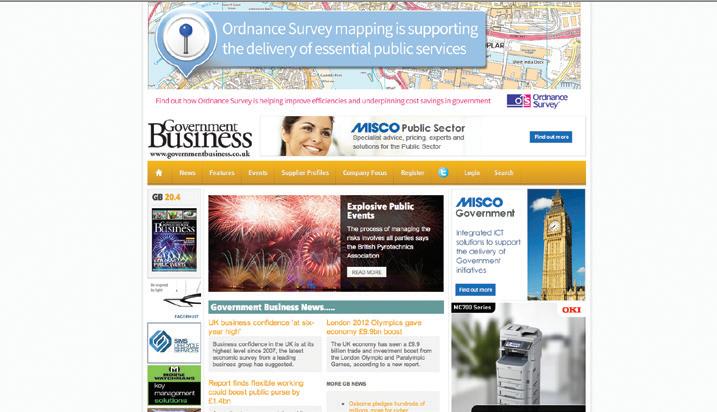

































Levelling up fund awards £2.1 billion; Wales announces plans for 100 per cent renewable electricity sources; and 800 new homes for rough sleepers in London

Dr Philip Orumwense commercial director and chief procurement officer for technology at Crown Commercial Service (CCS) discusses how CCS can help the public sector with technology procurement, including the G-Cloud 13 agreement
20
On 8th December 2022, we welcomed estates and asset professionals to the Smart Asset & Estate Management Conference at the QEII Centre, London. The conference looked at how to transform the public estate for a greener and smarter future
21



Sir Stephen Timms, chair of the Work and Pensions Committee discusses ‘The Health and Safety Executive’s approach to asbestos management’ report
25
Dyl Kurpil, managing director, District Enforcement explains how the latest technology provides both a proven deterrent to fly-tipping and improved evidence to ensure offenders are identified and fined
30
Chris Leslie, chief executive, Credit Services Association on how local authorities can recover their debts
32
Gordon McFarlane, president of the Public Services People Managers Association and assistant director in Leicestershire County Council examines recruitment in the public sector
34
Former energy minister Chris Skidmore recently published his independent Net Zero review, “Mission Zero”. GB looks into some of its main points and recommendations
38
Polly Billington, chief executive of UK100 explains how skills for local net zero can help the UK reach its net zero ambitions
The Mayor of London’s Rewild London Fund aims to improve London’s network of wildlife sites, help connect people to nature and better support the capital’s wildlife
The Feed Ducks Initiative provides a sustainable approach to feeding the ducks in public parks

The Safety and Security Event Series, featuring six different shows, is taking place at the NEC Birmingham on 25-27 April
The UK has a target of being net zero by 2050. With the deadline approaching, how can the events industry play its part and how can you run a net-zero event?


53 International Confex
International Confex is taking place at ExCeL London on 1-2 March 2023
Futurebuild 2023 will take place from 7-9 March 2023 at ExCeL London
UK Cyber Week – Expo & Conference is taking place at the Business Design Centre, London on 4 and 5 April 2023

By Ian McCormack, NCSC deputy director for government resilience, and Emily Mayhew, DLUHC cyber policy lead
64
With new and innovative ways to de-fraud the public sector it’s important to keep up to date with the risks, de-mystify threats and understand how to protect and prevent attacks


Having missed out on being European Capital of Culture due to Brexit and losing out in the bid to host Eurovision, in 2023, the city of Leeds is hosting a year of cultural celebrations
In this issue’s Expert Panel, we talk to Gary Bennett, regional director UK & Ireland, Clare Thomas, head of applications & solutions, Logic and Phil Grey, head of strategic sales at Urbis Schréder about the importance of good lighting for towns and cities

Poor data management. Integration issues. Lack of standards for data collection.
Just some of the challenges government departments are facing as they work towards the goals of the National Data Strategy.
Read more in our latest research. Download now

More than 100 projects have been awarded a share of £2.1 billion from Round 2 of the Levelling Up Fund.
The money will be spent in England, Wales, Scotland and Northern Ireland, with £627 million for better transport links, £821 million for community regeneration and £594 million to restore local heritage sites.
111 areas have been awarded funding from the fund which intends to create new jobs, drive economic growth, help restore people’s pride in the places where they live, and spread opportunity more equally.
Beneficiaries from Round 2 include the Eden Project North visitor attraction in Morecambe, a new AI campus in Blackpool, a new rail link in Cornwall, and a major regeneration scheme in Gateshead.
It has also been announced that there will be another round of funding from the Levelling Up Fund.
Prime Minister Rishi Sunak said: “Through greater investment in local areas, we can grow the economy, create good jobs and spread opportunity everywhere.
“That’s why we are backing more than 100 projects with new transformational funding to level up local communities across the United Kingdom.
“By reaching even more parts of the country than before, we will build a future of optimism and pride in people’s lives and the places they call home.”
Cardiff Crossrail has been awarded £50 million to improve journeys to and from the city, £27 million has been awarded for a ferry for Fair Isle in the Shetland Islands and £5.1 million is to be spent on building female changing rooms in 20 rugby clubs in Northern Ireland.
“I am very pleased that they propose a pathway for us to meet the equivalent of 100% of our annual electricity consumption from renewable electricity by 2035, and to continue to keep pace with consumption thereafter.”
A full list of recipients is available on the gov.uk Levelling Up website, as is an interactive map showing the projects across the country.
Levelling Up Secretary Michael Gove said: “We are firing the starting gun on more than a hundred transformational projects in every corner of the UK that will revitalise communities that have historically been overlooked but are bursting with potential.
“This new funding will create jobs, drive economic growth, and help to restore local pride. We are delivering on the people’s priorities, levelling up across the UK to ensure that no matter where you are from, you can go as far as your talents will take you.”
The Fire Safety (England) Regulations 2022 came into force on 23 January, implementing the majority of the Grenfell Tower Inquiry recommendations.
Welsh climate change minister, Julie James, has published a consultation on targets for Wales for meet 100 per cent of electricity needs with renewable sources by 2035.
Wales already generates 55 per cent of its electricity from renewable sources.

The minister also announced a target for at least 1.5 GigaWatt of renewable energy capacity to be locally owned by 2035, excluding heat pumps.
There is also a target for 5.5 GigaWatt of renewable energy capacity to be produced by heat pumps by 2035 but this relies on scaled up support from the UK Government and reductions in the cost of technology.
James said: “Our previous targets signalled our high ambitions for renewable energy and this Government’s desire to move away from a use of, and reliance on, fossil fuels.
“However, the climate crisis shows that we cannot afford to rest on our laurels. Providing new targets compels us to stride towards Net Zero as quickly as we realistically can.
“The evidence is clear that towards the end of this decade we will need to rapidly ramp up our generation of electricity to meet our energy needs.
“The renewable energy target proposals that we are consulting on today are ambitious, but credible.
£1 million of funding has been announced to explore the potential of offshore wind. This funding will be matched by Associated British Ports for preparatory work to enable future floating offshore wind projects to deploy from Wales.
Andrew Harston, regional director, Wales & Short Sea Ports added: “Associated British Ports warmly welcomes this early-stage support from Welsh Government to help kick start the development of a major green energy hub at Port Talbot. This support is key to the construction of transformational infrastructure, which will enable the manufacturing, integration and assembly of floating offshore wind components at Port Talbot.
“The roll-out of floating offshore wind in the Celtic Sea offers a once-in-a-generation opportunity for South Wales to lead a global market and will play a major role in contributing to Wales and the UK’s net zero targets. By doing so it will support and create thousands of long-term, high-quality jobs.
“As the gateway to the Celtic Sea, and with unique capabilities and natural advantages, this support will help position Port Talbot at the heart of these emerging green technologies and industrial decarbonisation.”
The new regulations include a requirement for ‘responsible persons’ of mid and high-rise blocks of flats, who will provide information to fire and rescue services to help them with operational planning and provide additional safety measures. Residents of multi-occupied residential buildings should be provided with fire safety instructions and information on fire doors.
Responsible persons will be required to provide their local fire and rescue service with up-to-date electronic building plans and information on the design and materials of their external wall; undertake monthly checks of firefighting lifts, evacuation lifts and other key pieces of firefighting equipment and install a secure information box and wayfinding signage.
In mid-rise residential buildings (over 11 metres), responsible persons will be required to undertake annual checks of flat entrance doors and quarterly checks of all fire doors in the common part.



Minister for crime, policing and fire, Chris Philp, said: “I am very pleased that measures to improve fire safety in blocks of flats are now law following recommendations made by the Grenfell Tower Inquiry.
“Keeping the public safe is our utmost priority and we are committed to ensuring that the Grenfell tragedy must never happen again.”



The BCC’s Quarterly Economic Survey (QES) for Q4 2022 shows key economic indicators have stabilised at concerningly low levels, following significant declines in Q3.
The survey of over 5,600 firms – 92 per cent of whom are SMEs – reveals business confidence, conditions and sales have stabilised at low levels, while inflation remains the top external factor of concern.
The research took place between November 7 and November 30, across the period the Government’s Autumn Statement was announced.
The percentage of firms reporting increased domestic sales has stabilised at the low level reported in Q3. Only 33 per cent of firms experienced an increase in sales over the past three months, while 25 per cent of firms reported a decrease in sales
and 42 per cent report no change.
Activity in the retail and hospitality sectors remains particularly weak. Both sectors are firmly in ‘negative territory’, with more firms reporting a decrease in sales than an increase over the past three months.
The hospitality sector is also struggling to operate at full capacity; three quarters (74 per cent) of hospitality businesses reported they are operating below capacity. More firms continued to report decreased cash flow versus increased cash flow. Only 24 per cent of business said their cash flow has increased over the last three months, while 30 per cent have seen it decrease.
After business confidence plummeted in Q3, firms continued to report a negative outlook for the future in Q4. Less
Levelling up secretary Michael Gove has given a speech at the Convention of the North.

He began by talking about what needs to change, including stunted economic development and the over-financialisation of economies and criticised partnering with authoritarian regimes.
Gove said: “And of course bureaucratic reporting requirements that have sometimes elevated abstract goals that please pressure groups ahead of concrete gains that deliver for the poorest.
“We have also seen supply chains that lack resilience and in some countries education systems that lack rigor.
“And linking them all of these phenomena has been a preference among some policymakers for models that appeal to theorists and think tanks rather than action rooted in real people and real places.”
Gove highlighted a lack of suitably qualified workers, limited supply of financial capital, and poor connectivity in terms of physical transport links and digital infrastructure.
He also mentioned the North-South Divide, which means that: “Wealth, influence, innovation, high productivity firms, high wage jobs and high quality schools have been disproportionately concentrated in the southeast quarter of the country.”
On what the government will do to address these problems, Gove said: “the moral imperative of reducing inflation is heart of everything we do.”
He also mentioned reforms to financial services to better support industry and manufacturing, securing investment from abroad and addressing economic inactivity.
Other action areas include tackling deprivation, investing in improved links between and within communities, and directing research and development to underfunded regions.
READ MORE
than half (44 per cent) of firms expect their turnover to increase over the next 12 months, while 25 per cent expect a decrease. Those expecting turnover to increase remains ten percentage points down from a level of 54 per cent in Q2 2022. Profitability confidence remains much weaker than turnover confidence and has stabilised at Covid-crisis levels. Only one in three (34 per cent) businesses believe their profits will increase over the coming year, while 36 per cent now expect a decrease.
The North Anglesey Regeneration Fund was launched on 23 January to make environmental improvements, help businesses and support local events.



Funding has been awarded by the Nuclear Decommissioning Authority (NDA) to regenerate the area. £50,000 is being made available for schemes that can be delivered by 31st March.

Small grants of up tp £7,500 are also being made available to help businesses and community groups in the Talybolion and Twrcelyn wards, and the community of Moelfre, to deliver projects which will support the County Council’s North Anglesey Regeneration Plan. £117,000 has already been awarded to local businesses and community groups to support job creation and improve the vitality of the area.
Anglesey Council Leader and Talybolion county councillor, Llinos Medi said: “Valuable funding received from the NDA has clearly been put to good use over the last two years, helping to regenerate North Anglesey. This additional money will further contribute to driving the North Anglesey Economic Regeneration Plan and I would encourage local businesses and community groups to apply if they have projects that meet the relevant criteria and can help regenerate their local communities.”
Applications for the fund are open now and must be submitted before 10 February.
READ MORE
electricity and renewable hydrogen to support decarbonisation across Europe.
Net zero & energy secretary Michel Matheson said: “Scotland is an energy rich nation, with significant renewable energy resource, a highlyskilled workforce and innovative businesses across a globally renowned supply chain.
“The renewables revolution is global, as all countries seek to address concerns about climate change, and Scotland is at the forefront of this transition.

The Scottish Government has published the draft Energy Strategy and Just Transition Plan, setting out a plan for Scotland’s renewables revolution as North Sea basin resources decline.
The plans would lead to a net jobs gain in the energy production sector, and a potential increase in renewable energy exports.
The plan has been published for consultation, which will run until 4th April 2023.
Proposals include increasing the current level of 13.4 Gigawatts (GW) of renewable electricity generation capacity, with an additional 20 GW by 2030; an ambition for 5 GW of renewable and low-carbon hydrogen
power by 2030, and 25 GW by 2045; and increasing contributions of solar, hydro power and marine energy.
Other proposals are to set out final policy positions on fossil fuel energy, including consulting on a presumption against new exploration for North Sea oil and gas; accelerating decarbonisation of domestic industry, transport and heat in buildings and increasing access to affordable energy by urging the UK Government to take stronger, more targeted action for fair energy market reform.
There are also plans for the generation of surplus electricity to enable export of


“At a time of unprecedented uncertainty in our energy sector, accelerating the transition towards becoming a renewables powerhouse makes sense for a number of reasons –particularly to helping to mitigate against future global market volatility and the high energy prices which are making life so difficult for so many people across Scotland. For example, onshore wind is one of the most affordable forms of energy.
“While we do not hold all the powers to address these issues at source, this Strategy sets out how we can achieve an energy transition that ensures we have sufficient, secure and affordable energy to meet our needs, support Scotland’s economic growth and capitalise on future sustainable export opportunities.”

The Mayor of London has announced funding for up to 800 new homes for rough sleepers in the city.
Sadiq Khan made the announcement during a visit to a Crisis at Christmas service in Newham, where he met people who have been sleeping rough and staff from Crisis and St Mungo’s. Crisis at Christmas, a partnership between Crisis, St Mungo’s and City Hall, has been extended into the new year for the second year in a row, so guests have somewhere safe and warm to stay until mid-January.
The Mayor of London has been allocated around £75 million from the Single Homelessness Accommodation Programme (SHAP), which will be used to deliver homes and support for young homeless people and rough sleepers with complex mental health or substance dependency issues.
Housing associations, local authorities, and charities will be able to bid for the funding later this financial year. Individual funding allocations will be approved by Government and City Hall.

The Mayor of London, Sadiq Khan, said: “Since becoming Mayor, I’ve made it a personal priority to tackle rough sleeping and we’ve helped a record 13,500 people off the streets through
our support services as we work to build a fairer London for all. But the hard work doesn’t stop here and I’m pleased that City Hall has secured funding to deliver up to 800 homes for Londoners sleeping rough.
“We can’t do this alone, and to end rough sleeping in our capital, particularly amid the cost of living crisis, the Government must intervene to prevent the circumstances that lead to people sleeping rough before thousands more are forced to face a winter on the streets.”
Matt Downie, Crisis chief executive, added: “We know the life changing impact our services over Christmas, and all year round, can have on people experiencing homelessness, so it’s been fantastic to work alongside the GLA and the wider homelessness sector once again in
extending our Christmas hotels through to the end of January.
“But our services are just the start of someone’s journey and to end their homelessness long-term we need accommodation that is safe and affordable. That’s why this funding for more homes for people to rebuild their lives in is hugely welcome. With rapidly rising rents and the cost of living crisis pushing more and more people into poverty and destitution there has never been a more pressing time to ensure that people are protected from life on the streets.”

Business and energy secretary Grant Shapps has warned energy suppliers to stop mistreating customers.
Shapps has written to energy suppliers asking them to stop forcibly moving consumers over to prepayment meters without taking every step to support consumers in difficulty.
Shapps has asked suppliers to discuss possible further action they can take to support customers before forcibly fitting prepayment meters. He has also asked suppliers to share the number of warrants they have applied for, with the number rising.
Shapps said: “Suppliers are clearly jumping the gun and moving at risk customers onto prepayment meters before offering them the support they are entitled to – I simply cannot believe that every possible alternative has been exhausted in all these cases.
“I am deeply concerned to see reports of customers being switched to prepayment meters against their will, with some



disconnected from supply - and quite literally left in the dark.
“Rather than immediately reaching for a new way to extract money out of customers, I want suppliers to stop this practice and lend a more sympathetic ear, offering the kind of forbearance and support that a vulnerable customer struggling to pay should be able to expect.”
Prepayment meters are intended to allow customers to pay for gas and electricity on a pay-as-you-go basis to help prevent debt and court action. Ofgem rules state that prepayment meters must only be used as a last resort, but numbers have increased since energy prices increased.
Minister for energy and climate Graham Stuart said: “Switching users onto a prepayment plan should only ever be a very last resort and suppliers have a duty to exhaust all other avenues. It cannot be right that, at a time when consumers need compassionate treatment more than ever, so many are being let down in this way.
The government has hit its target to switch over a quarter of its central fleet cars to ultra-low emission vehicles (ULEV).
As set out in the Department for Environment, Food and Rural Affairs’ Greening government commitments in 2021 to 2025, the government was required to transition a minimum of a quarter of its car fleet to ultra-low emission vehicles by the end of 2022. As of the latest data from September, 25.5 per cent of all central government cars were ultra-low emission vehicles, reaching the target three months ahead of schedule.
Technology and decarbonisation minister Jesse Norman said: “As the UK moves towards a cleaner transport network, the government is doing its part, with over 25 per cent of its central car fleet being batterypowered 3 months earlier than planned.

“It’s critical that progress in decarbonising fleets is matched elsewhere. We will continue to forge ahead, to complete the switch by 2027 and help make the UK a world leader in decarbonisation.”
The target is just a first milestone as government looks to decarbonise the entirety of its central car and van fleet to zero emission vehicles by 2027.
READ
MORE

The Department for Levelling Up, Housing and Communities has announced funding for brownfield sites to be redeveloped to deliver new homes.
Councils in England are able to bid for a share of £60 million from the Brownfield Land Release Fund 2, which aims to bring neglected urban areas back into use, support regeneration projects and boost local economies.
The funding is set to deliver 5,800 homes by March 2027, create around 18,000 jobs and help first-time buyers into homeownership.
£35 million from the full brownfield fund of £180 million has already been allocated, with the rest set to be allocated over the next two years. The full fund is expected to
deliver 17,600 new homes and 56,000 new jobs.
Minister for housing Lucy Frazer said: “We want to turn neglected areas into thriving new communities, as part of our mission level up the country.
“To do this we must prioritise brownfield land to deliver new homes for people, in the right places.
Citizen experience may seem like a nascent concept, or even nice-to-have against the backdrop of recession, cost-of-living crisis and the mantra of do more with less. But a commissioned study conducted by Forrester Consulting on behalf of Adobe, looking at how government agencies have implemented Adobe Document Cloud and Experience Cloud, suggests the cost savings and business benefits of creating better public sector experiences are significant
There is a growing expectation among citizens for better experiences. Today, people don’t compare their experiences with public bodies to other public bodies. They compare them to their last, great experience with digital leaders like Argos, EE, First Direct, Ocado and (of course) Amazon and Netflix. In fact, in the US, great customer experience is mandated by law and has been the subject of a presidential executive order. Adobe’s simple, seamless and secure solutions are widely used by US government agencies to help them deliver on the Executive Order on Transforming Customer Experience and Service Delivery to Rebuild Trust in Government. Issued in December 2021, it puts better customer experience right at the heart of improving services for US citizens.
Here at Adobe, we wanted to better understand the economic impact of implementing our software, so we commissioned Forrester to produce a study, published in September 2022.

Forrester conducted interviews with six US organisations in the public sector or serving public sector organisations around the world asking about their experiences of Adobe Document Cloud and Experience Cloud. The results were amalgamated into a composite organisation, adding together the benefits to arrive at a single figure representing the total value to all six agencies as if they were one organisation. Overall, they found a 205 per cent return on the investment in Adobe’s products over three years. And one of the biggest improvements was in the reduction of paperwork.
In the US, paper-based operations, including widespread use of fax machines, have persisted. In fact, fax machines were such a problem that Centers for Medicare and Medicaid, which administers the governmentrun health insurance programme, wanted their use ended by 2020. The NHS was banned from buying fax machines from 2019, with a total phase out by April 2020 proposed by the then health secretary.
And according to the Executive Order, the paperwork required by federal agencies takes the public a staggering nine billion hours a year to complete. That’s just the time for the forms to be completed: the processing time is unknown. There is an enormous opportunity here to cut the administrative burden for citizens
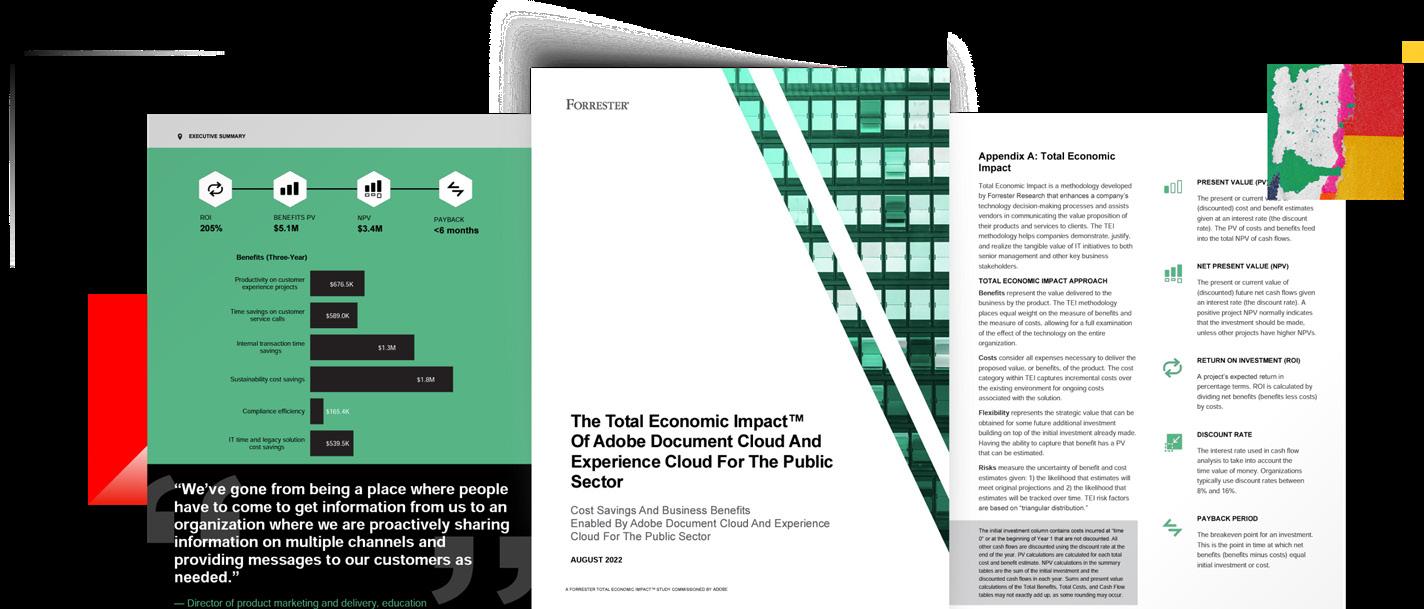
and government departments, and digital documents are part of the answer. Forrester’s study found that by saving documents as digital files, and making them accessible for mobile devices, the government agencies cut transaction times for customers by 30 per cent. That frees up staff to do other things, such as handling more complex enquiries. There is also a sustainability gain. Reducing your reliance on physical documents, with their associated printing, sending, scanning and even faxing, cuts the amount of resource you use. And in the era of remote and hybrid workforces, the need to get documents sent, completed and returned quickly takes on a new importance. With fewer people working from centralised offices, transferring information internally is no longer just a case of taking a physical document to another floor.
Creating the documents in the first place also benefits from digital technology. Forrester’s interviewees said that templates for digital forms made it much easier to create the forms: staff built the forms themselves, without the need for specialist IT involvement. It also made translating content into different languages quick and easy. Managing content across multiple sites is a major admin challenge, made considerably easier when it’s done using content management software built for the job.
Customer service
on the front line
Covid-19 and the ensuing economic fallout, coupled with massive geopolitical uncertainty, have tested the resilience of customer service operations like never before. Anything that can relieve the pressure on agents in call centres helps organisations and customers.
The pandemic itself reinforced the importance of solid, reliable and helpful digital operations. When seeing someone in person wasn’t an option, and when accurate information was at a premium, people came to rely on government websites. The ability to quickly update information and change site structures without the need for complex, costly and timeconsuming development became crucial. Today that need still exists. Any organisation providing the information its customers are looking for via a digital property will save itself, and its customers, time and effort. Fewer and fewer people want to call customer services. Most want to find the answer on a website or an app, and – if they can – it saves service agent hours being spent on resolving simple queries that could be handled without their involvement.
The US government agencies interviewed by Forrester found that by doing this, and by using analytics data from Adobe Experience Cloud, they reduced the time service agents spent on calls and emails by 50 per cent. That’s not because they want agents to spend less time with customers: quite the opposite.
By removing the need to deal with routine enquiries that can be answered using selfservice (such as ‘what time do you open’ and ‘how do I renew my prescription’), agents get more time to deal with more complex queries; the sort of queries that require human involvement to solve.
The idea that government systems need to be built in-house from scratch is understandable, but private sector collaboration and components can provide a fast, efficient route to successful outcomes. During the pandemic, the Department for Health and Social Care needed to distribute PPE across the country. Initially it used a straightforward, simple portal to solve the urgent need for PPE, but in the long run, it needed something more sophisticated.
Using Adobe Commerce, the DHSC created a platform that brings the functionality and customisation of a powerful commerce solution to the vital job of supplying PPE to the UK’s health service. By putting customer needs first, the solution has successfully delivered billions of items of PPE to users from 58,000 registered providers.
The Home Office’s EU Settlement Scheme app, which allowed EU nationals to prove their settled status in the UK, is another successful example. It’s powered by Canada’s WorldReach Software, a specialist identity verification company with long experience of passport control, immigration and border management.
Forrester looked at how Adobe’s Experience Cloud helped the organisations it surveyed save time and money. By using Adobe products, the composite organisation cut IT involvement by 75 per cent and reduced the cost by 30 per cent in year 3. It also reduced the time spent on regulatory compliance by 2,700 hours, because documents and assets created with Adobe’s products have compliance built in.
There’s also the issue of compatibility with other solutions. Legacy IT is unavoidable, so any new solutions have to work with existing systems. As the Forrester study states “IT teams also avoided work [thanks to] Adobe Experience Cloud’s support for integrations
with a wide range of CMS and workplace technologies, including Microsoft solutions.”
There’s more to this than saving money
Modernising the customer experience is directly linked to modernising the technology used to create it. It will not be possible to create a paperless NHS, HMRC or DWP using the systems in place today, and unless wholesale adoption of digital document and signing technology is achieved, it will never happen.
The technology exists to achieve these ambitions, and experience from the US shows the immense benefits of what are relatively easy changes to make. They’re also hugely cost effective, providing an enormous return on investment.
And it does not have to be a disruptive, difficult process. Products such as Adobe Acrobat Sign are in widespread use across the globe – they’re easily available and easy to use. It doesn’t (and indeed shouldn’t) require time-consuming and expensive IT involvement. The fact it doesn’t is emblematic of the ease with which such systems integrate with legacy technology, and how straightforward they are to use.
Forrester estimated that by using Adobe Acrobat and Experience Cloud, its composite organisation saw benefits worth $6.25m. But there’s much more to these benefits than can be measured on a spreadsheet. Using ready-built solutions helps to overcome the digital skills gap, a major barrier to creating better experiences. In Adobe’s 2022 Public Sector Digital Trends report, 61 per cent of public sector staff say their organisation lacks critical skills. Technology that’s easy to set up, use and maintain goes a long way towards addressing this issue. The intangible benefits of improved customer experience are just as, if not more, important, especially when we’re talking about services that people rely on. Better service means better outcomes, and when those outcomes are the life chances of school children or benefits payments to those in need, good customer experiences really matter. You can now download the full report, including detailed calculations. L
https://adobe.ly/TEIpublicsector
T e c h n i c a l S o l u t i o n s , A g i l e D e l i v e r y
H O W W E D E L I V E R
D E L I V E R I N G O U T C O M E S
F r o m c r e a t i n g M V P s a t D i s c o v e r y s t a g e t h r o u g h t o P r i v a t e B e t a , L i v e a n d R e t i r e m e n t , B e t t e r G o v t e a m s c a n h i t t h e g r o u n d r u n n i n g a n d d e l i v e r e n d - t o - e n d p r o g r a m m e s o r s p e c i f i c w o r k p a c k a g e s .
B U I L D I N G A G I L E T E A M S
O u r a g i l e a n d s c a l a b l e d e l i v e r y m o d e l a l l o w s u s t o r a p i d l y m o b i l i s e o u r t e c h n i c a l a n d d e l i v e r y t e a m s , a l i g n i n g s p e c i f i c s k i l l s , s e c u r i t y c l e a r a n c e r e q u i r e m e n t s a n d i n d u s t r y s p e c i f i c k n o w l e d g e ( i . e . , G D S S e r v i c e S t a n d a r d s , T e c h n o l o g y C o d e o f P r a c t i c e a n d C l o u d F i r s t P o l i c y e t c ) S t a n d a l o n e , o r e m b e d d e d i n t o C i v i l S e r v a n t t e a m s t o c r e a t e a t r u l y c o l l a b o r a t i v e d e l i v e r y m o d e l
D i s c o v e r y
D e s i g n a n d B u i l d
M i g r a t e a n d V a l i d a t e
M o n i t o r a n d O p t i m i s e
D a t a A n a l y t i c s
D a t a V i s u a l i s a t i o n
D a t a A r c h i t e c t u r e
D a t a E n g i n e e r i n g
S o c i a l C a r e
E d u c a t i o n
H o u s i n g
C l i n i c a l


ATAS2 (Audit Trail Analysis Service) is DWP’s strategic platform for the storage of business audit data that was remediated to On-Premises Hosting in 2018 and is currently being migrated into the cloud, supported by the BetterGov team.
At The Department for Work and Pensions (DWP), with digital services being delivered at high velocity and new technologies, current ATAS2 services require updating and complimenting with new approaches/ patterns to consume and serve data.

Customers were seeking new ways to integrate their new services with ATAS2. Having successfully delivered the ADaaS (Audit Data as a Service) Cloud migration Discovery Phase, BetterGov were engaged to conduct the ATAS2 Discovery Phase, in line with the Government Digital Service (GDS) guidelines, to validate the need for the product and to affirm DWP’s intention to evolve ATAS2 firmly into the SRA space.
Mobilising our SC-cleared Discovery team swiftly and assigning BetterGov team members with prior DWP experience allowed us to make an immediate impact and begin adding value from day one. Our focus was to understand the current landscape, problems faced and risks and outline goals which will inform an approach for the Alpha phase, prioritising the key problems/value areas anticipated. Using an Agile approach and working in sprints allowed BetterGov to quickly clarify perceived confusion about Business Audit, ranging from terminology and remit to the purpose and goals. Working collaboratively with key DWP staff and having a good understanding of governance structures and internal approval processes meant that BetterGov were able to effectively draw out the desired information from stakeholders and users to ensure the proposed options, recommendations and plans were as efficient as they could be.
Through the blended team approach, we were able to organise workshops with
various stakeholders to develop a problem statement and define the Operating Model for the SRA Business Audit Product. BetterGov delivered a detailed document on standardised data pattern based on the stakeholder engagement, to identify the scope for reuse for other approved SRA products. As part of User Research, we produced a user journey map to demonstrate how the data could be onboarded and queried in different ways; determined the non-functional requirements to cover aspects such as accessibility, telemetry, security, performance, resilience, stability, monitoring and logging to ensure these are well documented; provided an end of discovery report with recommendations on how to progress to the next phase, including a high-level Delivery Plan for Alpha Phase and Architecture Roadmap. Succesful delivery of a Discovery with a 10-day mobilisation turnaround, 12-week delivery period, and delivering under budget by 35%! L

Dr Philip Orumwense commercial director and chief procurement officer for technology at Crown Commercial Service (CCS) discusses how CCS can help the public sector with technology procurement, including the G-Cloud 13 agreement
How does CCS help the public sector procure technology solutions?
CCS is the biggest public procurement organisation in the UK. We help customers get the best technology solutions at the best price, from laptops for schools to advanced cloud technology solutions for local authorities to help them with their digital transformation journeys. We provide access to an unparalleled range of technology products and services, all designed to help public sector organisations run more effectively and cost efficiently.
What is CCS doing to make it easier for customers to use agreements?
We’re constantly developing our commercial agreements to help customers make the best use of technology in the most cost-effective way.
Under the G-Cloud 13 agreement, we’ve introduced improved terms and conditions. For example, greater inclusion for the provision of day rate cloud support services along with introducing a fourth Lot for further competition for cloud support for larger, more complex requirements.

New Memorandums of Understanding (MoUs), negotiated throughout 2021/22 are helping customers get the best technology at the right price. It will now be easier for public sector bodies, no matter how big or small, to get better value for money cloud capabilities and cutting-edge technology.
What is your team working on right now?
We’re bringing to market several new, innovative commercial solutions including our ‘first-of-its-kind’ Big Data and Analytics agreement,
which aims to support the public sector to improve data use to drive efficiency and improve services. It has been developed in accordance with the National Data Strategy and will support the requirements of the government and the wider public sector as they continue to use data to innovate.
G-Cloud 13 and Cloud Compute 2 will continue to drive the transformation of cloud, storage and digital and technology professional services throughout the public sector. With a run rate of commercial benefits in excess of £1bn per annum, this presents an opportunity to become one of the foremost technology thought leaders in the UK.
What is your focus for 2022/23?
Our focus remains on leveraging the best value from our existing E
13theUnderG-Cloud we’veagreement, improvedintroduced terms and conditions
MD5 is one of the Leading Digital Forensics companies in the UK; delivering high quality, reliable eDisclosure and Digital Forensic Services for the Corporate Sector, Legal Profession, Law Enforcement and Government Agencies




Policies & procedures are ACPO & ISO 27001 compliant and we are ISO 17025 Accredited 9359 Schedule of ISO 17025 Accreditation (Click to view).
MD5 eDisclosure Service complies with the Requirements of The Cyber Essential Plus Scheme.
We are an Approved Supplier to the Crown Commercial Services Framework Agreement G-Cloud-13

suite of agreements. We’re continuously looking for opportunities to drive the message of aggregated buying.
We’re also preparing ourselves for the upcoming rules reform and its implementation in 2023. Our key priority is making sure that we understand how we’ll grasp the opportunities so we can bring even more power to our customers’ procurement.
How is CCS improving commercial capability for public sector customers?

The more spend that comes through our agreements, the more money we can generate to re-invest in raising the bar, investing in our own commercial capability and sharing that knowledge and expertise with our customers.
For example, right now we’re working to help our customers continue their digital transformation journeys. We support the cross-government technology code of practice, which is a set of criteria to help the public sector design, build and buy the very latest technology. The code of practice forms the basis of our new guide to digital transformation in local government, which we’ve created to help local authorities improve services for their citizens. We’ve aligned where our technology commercial agreements can support with addressing the key points in the guide.
How is CCS helping customers to make responsible decisions about sustainability and social value?
We’re continuing our work on providing sustainable technology solutions to ensure the government delivers on its commitment to carbon net zero.
Our Crown Hosting agreement provides data centre colocation facilities for the public sector, delivering significant cost savings and sustainability measures. Through this agreement, carbon savings in the region of 99.9 per cent are achieved from efficient hyperscale facilities and ‘Green Electricity’.
We’ll also be engaging with the various procurement policies including how we boost our own and our supply chain partners compliance to the modern slavery statement. And we’re accelerating our focus on growing our SME spend through our supply chains. Our SME engagement statistics for 21/22 are outstanding (total SME spend for technology through CCS agreements was £1.88 billion, representing 25 per cent of direct spend) but there’s more to do. L
To find out how CCS can help you make better buying decisions, visit crowncommercial.gov.uk
Dr Philip Orumwense is the commercial director and chief procurement officer for technology at Crown Commercial Service (CCS). Philip and his team help to manage over £10 billion of technology spend each year on behalf of public sector customers and in the last 18 months have increased commercial benefits for technology customers from £431 million to £1.2 billion

Our Crown Hosting agreement provides data centre colocation facilities for the public sector, delivering significant cost savings and sustainability measures



External procurement of IT services is well established in the public sector. Nevertheless, problems often arise, in the relationship or in the evaluation of service levels or pricing. Independent consultants can assist in putting the relationship and discussions on a stable footing
IT sourcing can be a meaningful solution, but also includes risks. For years, there has been a perception that one third to one half of contracts do not bring the expected success. On the one hand, this is due to a shortfall in service performance, but on the other hand, it is also due to misaligned expectations and general conditions.
Sourcing managers must prepare themselves as effectively as possible for each partnership, especially in times of volatility, uncertainty, complexity and ambiguity. To reduce the risk of a sourcing contract, it is important both sides proceed professionally: take enough time, prepare for the deal, bring realistic objectives and aim for meaningful goals. After all, the life cycle of a contract does not run on a straight road to the horizon, but often like a path through rough terrain. Even a small mistake or a misunderstanding can throw the vehicle off track.
Here are some issues we see impact sourcing processes time and time again: 1) Overly ambitious project plans lead to insufficient time spent in areas such as due diligence and negotiation, frequently leading to poorly scoped services with punitive pricing; 2) Unrealistic business cases and expectations almost always lead to disappointment further down the line; 3) Poor staffing and funding of the retained organisation leads to difficult service relationships. The skills required to manage a service provider are very different from the skills required to run a service. It is vital to have sufficient
people in the right roles with the right skills managing your service providers. An analysis undertaken with our clients demonstrates involving a third party advisor which specialises in sourcing ensures independence and objectivity during the process and will reduce cognitive biases during negotiation. The analysis shows sourcing engagements which involved a third party advisor delivered pricing approximately 6% to 10% better than engagements with no external input. Further analysis shows that if the sourcing specialist also has access to a database of real deal data, the outcomes from a price perspective can be dramatically better; 10% –20% better.

See our playbook for a series of thoughtprovoking insights you can apply to your sourcing processes: Download here
In the current climate, ensuring your IT contracts represent good value for money is vital. Running a tender process is an obvious part of the procurement lifecycle, however, if you have an opportunity to test
the pricing of your contract(s) mid-term this may yield valuable benefits. Market price benchmarks can have a significant impact on IT outsourcing prices during negotiation, whilst assessing running contracts and at the renewal phase. In our chart, we show the impact of a market price benchmark during the term of a contract. Evaluation shows 45% of outsourcing contracts include the implementation of a market price benchmark in the first twelve months, and another 40% in months 13 to 36. In two-thirds of the benchmarks analysed, prices were lowered by an average of 11%. IT services have differing performance, quality and costs depending upon how services are delivered and by whom. Performance and quality can be measured against SLAs and KPIs determined in the services contract, but knowing whether these are good when compared to the wider market is vital. Pricing may have looked good when the contract was signed, but whether those prices are competitive after the service has changed and the market has evolved, is crucial.

If the resulting performance compared to a peer group is not as desired, an improvement programme could be required, or in the case of the price benchmark, a reduction in contractual pricing.
Transparency of the financial makeup of your contract can make life much easier when dealing with stakeholders and explaining or justifying external spend. It also ensures a thorough understanding of factors such as the impact of volume on spend which, in a world where cloud usage is proliferating, can drive fundamentally better deal management.
IT services are a very costly affair, so it is critical to ensure prices are in line with the market. Many IT contracts include benchmark clauses for the very reason of ensuring the contract remains competitive over time. The cost of performing a benchmark is generally small in relation to the possible savings identified. In conclusion, how do you know whether your IT service pricing is value for money? Should you now consider conducting a benchmark? L
On 8th December 2022, we welcomed estates and asset professionals to the Smart Asset & Estate Management Conference at the QEII Centre, London. The conference looked at how to transform the public estate for a greener and smarter future


This brisk December morning was filled with excitement as the sector came together to share lessons learned from a post-covid world and hear the policy updates from the government. Sofie Hooper from the IWFM kicked off the event with a few words about the current landscape. Our chair shared the pressures the built environment is facing with hitting net-zero targets, tackling the facilities maintenance backlog and supporting professional development.
It was a pleasure to hear from Dr Janet Young, this year switching for Mark Chivers from the Office of Government Property who was unfortunately stuck in transit. Janet spoke about the Government School of Property and the increased push to continually train and learn new skills. This is Janet’s thirtieth year as a chartered surveyor, and she still feels the need to keep learning about new emerging technologies.
Mark Chivers arrived mid-morning to present the latest policy updates. Mark spoke about the government’s eight-year plan to create a smaller, better and greener estate. He stressed that the public estate is not to be underestimated as it is worth half a trillion pounds and optimisation is key. Architects Hawkins/Brown shared a different perspective through their tried-and-tested three-step approach to enhancing estates. Net-zero and sustainability were a common thread in most sessions throughout the day. Joe Tilley, from CCS remarked that “sustainability is not just a nice to have but it is something we need”. This sentiment was shared amongst his panel members who agreed it was time to stop planning and start acting. Jarron Reddy, from ENTRNCE told the audience it is not just about energy certificates, but net-zero can mean moving away from volatile hydrocarbons. Technology plays a big part in creating a more sustainable public estate. Thomas Dolby from Accruent explored how software
can help with energy management. He speculated that “the most effective way to tackle the energy crisis is reducing consumption”. Managing and tracking energy use is key to reducing cost and consumption which leads to smart and intelligent buildings. The team from Arcadis presented their business case for intelligent buildings. They explored their workspace 80FEN and shared lessons they learned.
However, as Ian Baker from EMCOR UK, shared, “an endless number of sensors doesn’t make a smart building”. With too much data, you risk analysis paralysis and the best way to combat it is by creating meaningful data. Michael Mifsud from Sopra Steria shared how once we have the data; we can leverage it to forecast and make predictive analysis and in turn use AI to help mitigate problems before they arise. Trevor Pope Ellis from Infogrid shared similar sentiments as their AI-powered platform gathers and analyses data from the smartest IoT technology to make every building healthy, efficient and sustainable. Data is a big driver in the estate landscape, but people are at the heart of it. Mark Duddy from the GPA shared an update on the Government Hubs Programme and the 16 new regional hubs that will be opened. He explained that the program is more than just buildings. It is a catalyst for a more fundamental change leading to the modernisation of the Civil Service. Modernisation was the key theme of Bridget Wilkin’s presentation. She unpacked the latest developments at the DLUHC and how digital citizen engagement is making the planning system more accountable and easier to use, with virtual and augmented reality tools making way for new voices to emerge.
The afternoon saw panel discussions about facilities management. Colin Cassé explained HMRC’s 10-year transformation
plan and how it was more than just physical buildings. They looked at inclusive design so the workplace can be for everyone. Another panel discussed the need for a streamlined occupancy management system to help with creating an efficient workplace.
The streams wrapped up with a presentation by Salix Finance about the decarbonisation scheme. They spoke about how to use data to analyse where the quick wins are and to plan for the longer projects. An effective place planning strategy while taking into account the fundamental needs of estates on a regional scale while considering budgetary requirements led the discussion in our closing panel. Sofie Hooper brought the conference to a close and reflected on the discussions throughout the day.
Next up in the estates’ conference series at GovNet is the National NHS Estates Conference on 19th April 2023. This conference offers a platform to discuss how to transform NHS estates to better meet the financial, operational and clinical demands. Complimentary tickets are available to the NHS and public sector, find out more below. L
FURTHER INFORMATION
https://hubs.la/Q01vKkcy0
The immediate and most visible priority for the secretary of state for work and pensions and the team of ministers will be supporting people through the cost-of-living crisis. However, there are many other pressing policy areas that The Department for Work and Pensions (DWP) must not ignore.
The Health and Safety Executive (HSE) reports to DWP. Among these important pending issues is how to deal with the threats to health and life that persist in buildings up and down the country.
Our Work and Pensions Select Committee report, published last April, highlights the continuing risk from asbestos.

Despite being banned more than two decades ago, the material remains in 300,000 UK non-domestic buildings. It is the single greatest cause of work-related fatalities in the UK, with more than 5,000 deaths in 2019, including from cancers such as mesothelioma. There has been a growing number of deaths from asbestos-related diseases among retired teachers and nurses, presumably resulting from exposure during their working lives.
The Health and Safety Executive (HSE) estimates that the total annual cost of deaths from mesothelioma is £3.4 billion and around
£3.1 billion for deaths from asbestos-related lung cancer. These figures attempt to put a price on the pain, grief and suffering caused to victims and their loved ones.
The extreme exposures of the last century are thankfully now behind us. But the drive towards retrofitting to meet net zero aspirations means the risk of asbestos exposure will only escalate in the coming decades. At the same time, the largescale changes to buildings which will be needed provide a timely opportunity to remove asbestos in a cost-effective way.
A key recommendation in our report is that this opportunity must be firmly grasped.
Current asbestos regulations devolve responsibility to individual building owners and maintenance managers. But this isn’t good enough, given the risk to human health. A new approach from DWP and the HSE is desperately needed.
The previous secretary of state for work and pensions, Chloe Smith, told our inquiry, when she was still minister for disabled people, health and work that the Government had a ‘clearly stated goal’ that ‘it is right to – over time and in the safest way – work towards there no longer being asbestos in non-domestic buildings’.
The Committee agrees with that goal, although we are not aware of it ever having been stated before. But it isn’t good enough merely to state the goal. Our report calls for a new systemwide strategy to remove all asbestos from public and commercial buildings. A clear target should be set, as the cornerstone of a properly joined-up strategy for dealing with asbestos. We propose that ministers should set a deadline of 40 years for its removal. The new strategic plan should focus on removing the highest risk asbestos first, as well as early removal from the highest risk settings, including schools. There also needs to be big improvements in the evidence E
Despite thanbannedbeingmore two decades ago, the material remains in 300,000 UK non-domestic buildings
base for safe asbestos removal and disposal, considering relative costs and benefits.
Enforcement
While the plan is being developed, there are other more immediate actions that can be taken. The HSE must do much more to monitor compliance with the current asbestos regulations and boost enforcement. The number of asbestos enforcement notices issued annually by HSE dropped by 60 per cent between 2011/12 and 2018/19.

Given a drop in government funding it is not entirely surprising that enforcement work has fallen over the past decade, but the level of decline in asbestos enforcement is much greater than for HSE enforcement work overall. There is certainly no evidence that compliance with asbestos regulations has improved dramatically during that time.
The HSE should commit to a sustained increase in inspection and enforcement activity and the government should make sure that the funding is there to support it.
As part of our inquiry we looked at how asbestos removal is handled in other countries, discovering that the direction of travel in Europe is towards tighter regulation and lower exposure limits for workers.
HSE made a fair point to us that European proposals may not necessarily be grounded in the real-world experience of asbestos exposure, and highlighted the problem of asbestos being so widespread in Great Britain.
An asbestos regulatory policy, however, which prioritises only that which is immediately practical risks tolerating poorer health standards, and higher costs in the longer-term. HSE should thoroughly assess

the move towards more stringent asbestos occupational exposure limits in Europe. The Government’s response last summer, before the change of Prime Minister, rejected our key recommendations, arguing that setting a deadline for removal would increase the risk of exposure. Such a stance fails to recognise that exposure is likely to increase in the coming years with more retrofitting of buildings as we approach net zero. This strategy should prioritise the highestrisk buildings and urgently boost the evidence
base for the safe removal and disposal of a material that is still the single greatest cause of work-related fatalities in the country. The secretary of state has an opportunity to pursue a new approach, and to commit to developing a plan that deals properly with this deadly material and its continuing harmful consequences. L
FURTHER INFORMATION
Read the report here.
An asbestos regulatory policy, however, which prioritises only that which is immediately practical risks tolerating poorer health standards, and higher costs in the longer-term
Twice2much discuss how Spend Recovery reviews, based on a ‘share of recoveries’ only, can help ease current financial pressures
investigate anomalies; evidence to support initial findings.
STAGE 3 – Recovery/Reporting
have resulted from managers having approved the same invoice at different times in the approval and payment process.
Many organisations have either not heard of Spend Recovery Reviews or do not consider that the recoveries and associated cash generated is likely to be applicable to them. With so many financial pressures on every organisation as a result of the COVID pandemic and recent inflation and energy costs surges, there has never been a more appropriate time to consider EVERY avenue for income generation.
As the cost of a review is based on a ‘share of recoveries’ with no upfront costs and limited/no internal resource requirements, undertaking a review of this type should bear serious and urgent consideration.
Twice2much specialises in ‘Spend Recovery Services’ working with finance directors, accounts payable managers and heads of audit to provide a comprehensive review of accounts payable spend.
We provide the time, resource and expertise that many in-house teams cannot justify resourcing internally.
Twice2much are an approved supplier on the Crown Commercial Service Framework RM6226, Lot 15 - Spend Analytics and Recovery Services, enabling organisations to procure this service quickly and simply, as the due diligence has already been undertaken on the procuring organisation’s behalf. Our recoveries made on behalf of clients to date demonstrate beyond doubt how we can help any client…
What does a Spend Recovery Review involve?
Our reviews enable clients to benefit from a ‘bespoke’ detailed forensic review of their organisations’ accounts payable transactions.
There are three stages to a Twice2much Spend Recovery Review:
STAGE 1 - Identification/detection
Access to £100,000’s of technology, including ‘bespoke’ analytic software and resources; access to dedicated experienced professionals; multiple-layer interrogation of transactions with suppliers; specialist expertise in reviewing supplier transactions and identifying anomalies.
STAGE 2 - Verification/validation
Expert detailed analysis of transactions at individual supplier level to validate and
Twice2much provide the system, processes and resources to recover the errors found on our clients’ behalf; flexible but targeted reporting provides significant additional benefits to clients.

A comprehensive process
Our reviews do not just identify potential duplicates but cover the whole process from obtaining data, identification and verification and includes recovery from suppliers.
It even includes raising all paperwork to enable processing of recoveries and comprehensive reporting.
What resources are required internally?
All reviews are carried out off-system, off-site and out of sight with a focus on ensuring minimal requirement for internal resources.
The only internal resource requirements are for the extraction of data, review of initial results and processing of refunds or corrections. Assistance is provided by Twice2much for all elements.
Why can’t we do these reviews ourselves?
The truth is you can...
You can either create or buy analytical software to find potential overpayments you may have made.
However, both scenarios require cash and time resource cost with no guarantee of any benefit and at a time when resources can be better focussed on core business services.
Our reviews involving significant established analytics and expertise operate on a ‘share of recoveries’ basis with zero upfront charges, thus incentivising us to find and recover more for you with minimal need for internal time and resource costs.
Many people mistakenly believe that if duplicates/overpayments are found by our reviews then accounts payable are at fault because they overpaid the supplier.
In my 30+ years of experience undertaking and managing reviews of this type, this could not be further from the truth, which I have explained to many finance directors and heads of finance and audit.
Rarely are payments made to a supplier without a manager’s approval and in nearly all cases, duplicates/overpayments identified
In these difficult times, it is essential that we think less about the blame game and more about the opportunities and cash generated that can help with the challenges we are all experiencing.
Who should be considering these reviews within your organisation?
Heads of audit, heads of fraud departments, heads of finance, and heads of accounts payable or procurement are the key individuals involved in considering and procuring these types of ‘specialised’ reviews. As ‘all’ Twice2much Spend Recovery reviews are undertaken on a ‘share of savings’ basis, they are in effect selffinancing, and therefore no budget or funding is required, limiting the need for a protracted procurement exercise.

How to procure a review
Crown Commercial Services ‘Framework’ RM6226, Lot 15 - Spend Analytics and Recovery Services can be used to procure the service either by direct award or by a limited tender exercise.
Public sector organisations can procure these services directly with accredited providers like Twice2much.
Benefits?
Recoveries from our reviews effectively represent an ‘unbudgeted financial windfall’ which can be used to directly address budgetary pressures, enable the provision of additional services and/or fund additional resource requirements.
Twice2much would be happy to provide more details or discuss how we can help you generate these benefits quickly and efficiently. L
www.twice2much.com





Beauparc provide tailore so that you save space, m recycling and reduce you to continually improve y

Beauparc provide tailored waste strategies so that you save space, money, increase recycling and reduce your carbon footprint to continually improve your sustainability.



Waste collections that space saving, waste mi recycling-led
Waste collections that are cost-effective, space saving, waste minimising and recycling-led


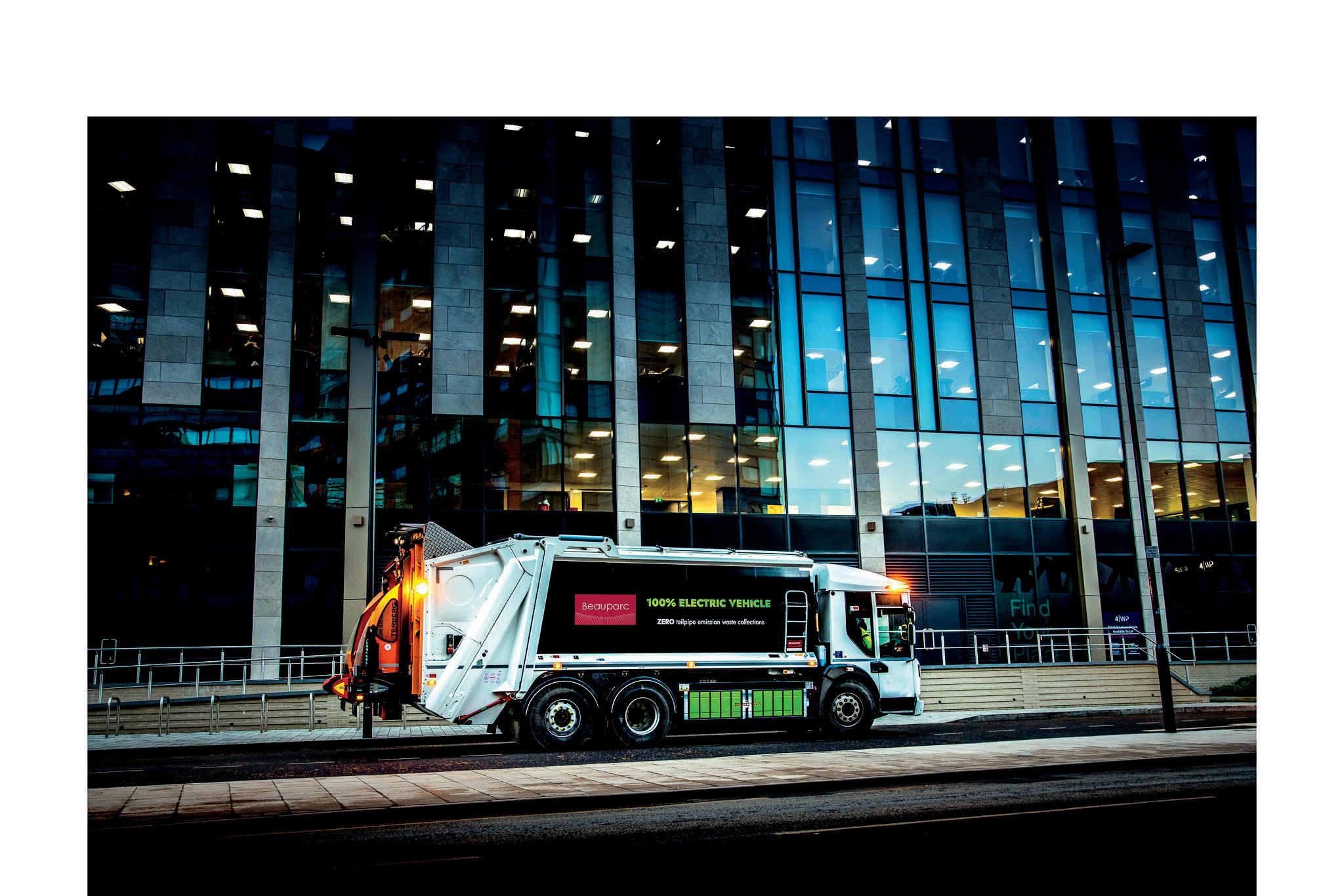


GDPR compliant shredding, onsite and offsite
GDPR compliant shredding, onsite and offsite


Skip hire and quick clearance service
Skip hire and quick clearance service
Complete and compliant hazardous waste removal including offensive, clinical, electrical & electronic waste (WEEE)
Complete and compliant hazardous waste removal including offensive, clinical, electrical & electronic waste (WEEE)



Big Belly solar-powered, sensor-equipped waste & recycling stations for public spaces
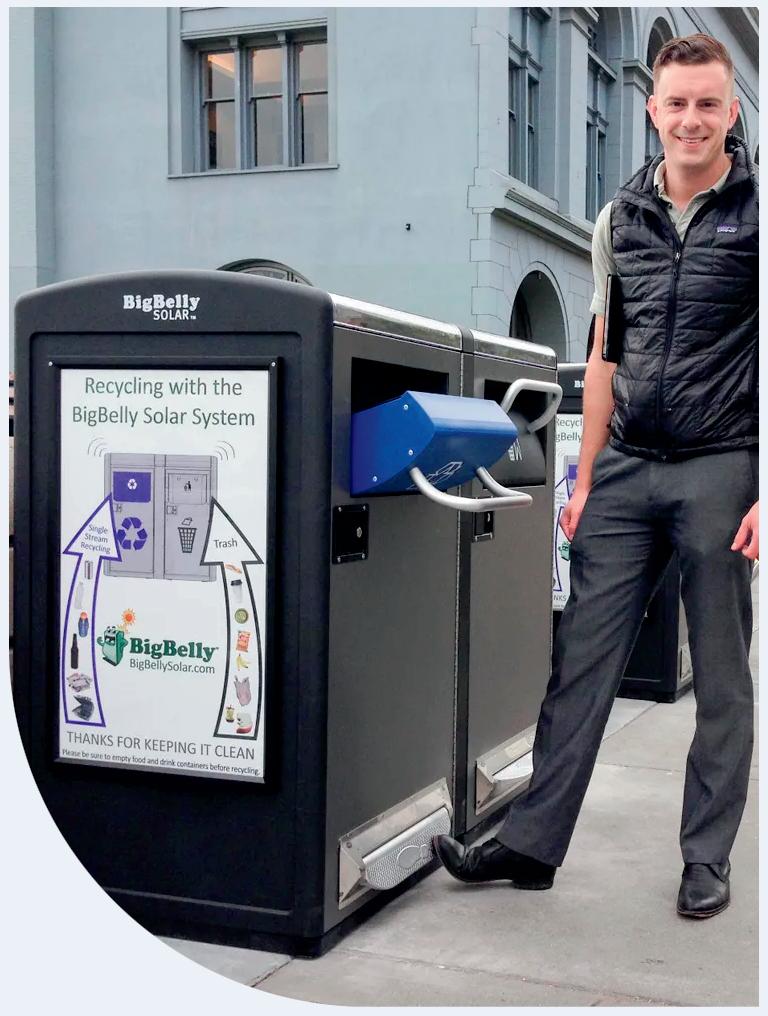

Big Belly solar-powered, sensor-equipped waste & recycling stations for public space
Experienced in the smooth roll-out of complex contracts across multiple sites, within various public sector organisations.
Experienced in the smooth roll-out of complex contracts across multiple sites, within various public sector organisations.
Contact us at marketinguk@beauparc.co.u
Contact us at marketinguk@beauparc.co.uk

Dyl Kurpil, managing director, District Enforcement explains how the latest technology provides both a proven deterrent to fly-tipping and improved evidence to ensure offenders are identified and fined

Intelligence is transforming the way Local Authorities crack down on fly-tipping. Combining high-resolution cameras with Artificial Intelligence (AI) and Automatic Number Plate Recognition (ANPR), is transforming the speed with which flytipping events can be identified – especially at public recycling points. With accurate, fast information, enforcement officers can be quickly on site, minimising the risk of degradation to evidence. Combining fresh evidence with the vehicle owner’s identification from the DVLA enables rapid identification of the fly-tipper. The result is a charge with a realistic prospect of success at prosecution, that can be disposed of by means of Fixed Penalty Notice (FPN) if appropriate.
Yet this efficient, effective approach is far from ubiquitous. While some Local Authorities are actively pursuing anti-fly tipping strategies, others are less proactive. Fly-tipping blights communities. For local authorities, the issue is not only the £392 million a year it costs, but also the risk to public health. Fly-tipping undermines confidence in local government; and can lead to a huge number of complaints that must be handled by an already stretched customer facing team.
Fly-tipping, by its definition, is never ‘Accidental’ – nor a reasonable defence. Yet despite excellent signage at recycling locations, many members of the public are either still unaware that leaving goods next door to a recycling bin is a criminal act – or wilfully ignoring the fact. It doesn’t matter if the bin is full. Or if access is restricted in some way. Whether it is a bottle, cardboard or electrical goods, failure to ensure the item is correctly and fully placed inside the dedicated bin or skip is fly-tipping and, if caught, will incur a Fixed Penalty Notice up to £400. For local authorities – and their outsourced contractors – this type of fly-tipping can incur very serious costs. Recycling bins are collected and emptied by machinery, and contractors have to charge more to manually clear up and dispose of mis-located items. Indeed, this can be just as costly a problem as clearing up the
headline-grabbing fly-tips undertaken by individuals who purport to be licensed waste disposal companies and then dump trusting householders’ goods in our lanes and woods. While this latter group is seen by the courts as being more serious, and they likely face a fine up to £50,000 or prison, all flytipping is an offence. Individuals are equally liable for a fine – if they can be identified. As investigation methods become more commonly known, offenders are taking steps to avoid identification – enforcement has become more difficult. Which is why so many Local Authorities are now turning to technology –both to identify fly-tippers and to act as a serious deterrent.
Intelligence led
The UK has very stringent legislation when it comes to the use of cameras E
Written by Dyl Kurpil, managing director, District Enforcement Waste ManagementtippFlying, by its definition, is never ‘accidental’ – nor a defencereasonable

The Goupil G4 is ideally suited to improve access into low emission zones, cities and town centres. With 11 different body configurations there is a Goupil to suit a number of applications.


for surveillance. Under the Regulation of Investigative Powers Act (RIPA), local authorities must justify the use of CCTV for monitoring fly-tipping just as the police have to justify the use of cameras for their covert policing. The regulatory demands are particularly onerous for covert surveillance, which is why local authorities typically use CCTV for overt surveillance – with highly visible signage informing citizens that they are being filmed.
While any use of overt surveillance is a proven deterrent, the latest generation of highresolution camera technology, combined with AI and ANPR, is helping in the identification of offenders and enforcement of offences. The AI, which has the capability to rapidly learn the correct size and colour of the bin/skips being filmed, can quickly identify an object left in the wrong place. Fly-tipping enforcement officers can be rapidly informed, allowing a faster response and less degradation of evidence.
The combination of recorded imagery and ANPR identification make the enforcement process far more effective. Once the DVLA provides the name and address of the registered owner of the vehicle on camera, an enforcement officer can visit the individual, armed with the evidence, and ask them to confirm or deny their role in the fly-tip. If they confirm, the officer can immediately issue an FPN – typically for £400, reduced to £200 for rapid payment. If they deny, a judicial process will then commence, supported by further investigation and the evidence captured by the technology deployed.
The adoption of intelligence-led fly tipping enforcement can drive behavioural change. In addition to acting as a deterrent, this approach reinforces the awareness and understanding of what constitutes fly-tipping. For example, an individual cannot claim to be unaware that they have fly-tipped when the recording clearly shows them reading the sign, lifting up the lid, seeing it is full and still leaving the recycling or litter.
It is, however, critical that organisations make the best use of technology. That means good quality images and cameras located in the correct place to maximise the ability capture the number plates. It means utilising tools such as AI to give enforcement officers the best chance of identifying offenders. And it means ensuring all the correct steps are taken legally, including excellent signage, to ensure citizens know they are being filmed.
The entire investment is recouped not only through the enforcement revenue but also by the lower costs associated
with clearing up fly-tipped waste; and a reduction in complaints from citizens. Furthermore, this frees up local authorities and enforcement services to concentrate on the organised criminal element, the gangs that not only dupe the public by posing as commercial operators but fly-tip at scale for commercial gain.

Conclusion
The annual investment required by local authorities to counter fly-tipping is unacceptable in a country wrestling with an array of challenges, not least the financial pressure on families during the current economic crisis. The use of technology to not only reduce fly-tipping but also improve identification is key to improving citizen understanding and minimising so called ’accidental’ fly-tipping events. L
FURTHER INFORMATION
https://district-enforcement.co.uk
Cromwell supply a range of EN13432 certified compostable caddy liners that can support food waste management strategies, delivered by Local Authorities.

Research has identified compostable liners as the preferred and recommended choice for the capture and containment of food waste.
The research concludes that compostable liners provide the most effective balance of reasonable costs, minimisation of plastic contaminants in the biodegradable waste stream and maximisation of total food waste collected and processed.
If you are a local authority looking to trial or introduce compostable liners to a separate food waste collection strategy, contact Cromwell Polythene today for more information, samples and pricing.
01977 686868 info@cromwellpolythene.co.uk www.cromwellpolythene.co.uk

The annual investment required by local authorities to counter fly-tipping is unacceptable in a country wrestling with an array of challenges, not least the financial pressure on families during the current economic crisis








Not many people relish the idea of paying their taxes – but our propensity to settle the sums we owe to our local authorities across the UK is pretty good, with over 95 per cent of bills paid within the year they fall due. Perhaps we are more likely to pay local taxes, fees and charges in the knowledge that they fund vital public services such as parks, social services and waste collection. Or perhaps as individuals we are aware that nonpayment or avoidance of council taxes and charges can have significant consequences. Approaches differ between Scotland, England and Wales because of the wider devolution settlement. In England, councils can request a means enquiry summons court hearing to determine whether non-payment of council tax is wilful or culpable. Courts can issue liability orders to require payment by various means, including deductions from earnings or benefits, enforcement agent action, a charging order placed on property assets or ultimately committal to prison. But these days local authorities are far more willing to engage with those struggling to make payments or in difficult financial or vulnerable circumstances.
The economic backdrop does not make the work of local authority collections any easier at the moment. The cost-of-living pressures facing households and small businesses are beginning to put greater pressure on payments. The latest data from the Office for
National Statistics shows that arrears and non-payment levels have grown significantly in the past few years. Whereas in 2017 there were £2.8 billion of council tax arrears owed to English local authorities, in March 2022 that number had risen to £5 billion. Similarly, the sum owed in unpaid non-domestic rates by businesses was up from £1.7 billion in 2017 to £2.6 billion last year. While this still represents a collections rate on council tax of 95.8 per cent in 2022 and of 95.5 per cent on rates, these are significant sums of money that could make an appreciable difference to the quality of lives and services in the community. Much of the arrears situation can be traced back to the COVID pandemic period, when local authorities (like many in the financial services sector) suspended recovery work and many of the court processes were paused with courts closed. A backlog has grown, not only in council tax but also in parking fees, social care fees and other sundry debts, and ultimately the recovery

pressures simply to maintain existing levels of service provision, the imperative to collect monies owed is strong. Many councils have sensibly sought to bring in external expertise and specialist help, with joint ventures with private sector collections agencies growing but often outsourcing the enforcement process rather than expecting these capabilities inhouse. Debt collection agencies are wellversed in working for non-FCA regulated organisations including local authorities, and can offer consultancy and training as well as direct service provision. There is a debate to be had about the extent to which local authorities can extend forbearance terms to those customers in need of more time to pay, because unlike many credit card or bank loan providers, some council bills are required by statute to be paid and collected within fixed time periods and of course are also automatically recurrent charges, such as the annual council tax. In this respect, it would be welcome

The facinglivingcost-of-pressures households and small businesses are beginning to put greater pressure on payments
work together to explore relaxing some of these time constraints that prevent a more flexible approach to forbearance from being developed.
When arrears occur, the private sector –especially the FCA-regulated consumer credit sector – have well-established processes to offer support, signpost advice and allow rephasing of payments, practices that have more recently been adopted in the public sector. At the Credit Services Association, our Code of Practice sets out best practice standards we expect from our members and which customers and businesses engaging with the collections sector should expect. While the code does not cover enforcement activities, it does set out common principles for the collections process so that member firms must show due diligence, care and competence in their work, treat customers fairly, communicate clearly, not subject customers to aggressive practices and exercise

forbearance and consideration of a customer’s circumstances. While there is not a universal code or governance protocol covering all UK public services in quite the same way, and FCA regulation also does not extend to public sector financial recoveries, we know that efforts are being made to coordinate improved standards across public authorities, for example in the approach taken to central government procurement of collections work and through the Cabinet Office Fairness Group.
Perhaps the key lesson to be learned from private sector collections is the value of early engagement. Many independent free debt advice charities say that the accumulation of problem indebtedness for those in financial distress is as much to do with debts owed to the state or utilities and not always about credit cards or loans. Preventing problems from compounding with appropriate signposting to advice and help is crucial. Debunking misconceptions and encouraging
open dialogue is crucial, and local authorities have a key role in urging individuals to take a first step to talk to creditors and collections agencies. Communications that emphasise the support that is available, as the CSA’s #heretohelp campaign has highlighted www.csa-uk.com/heretohelp), can make a real difference. Ultimately all the evidence is clear that the sooner people engage, the more chance there is of reaching a solution acceptable for them and for the creditor too.
Rather than defaulting to enforcement action as may historically have been the practice in some councils, those local authorities who allow residents a ‘breathing space’ and consider things from the perspective of the person in debt will have a better understanding of possible solutions. If there is a default on a council bill, the chances are there may be other defaults with other creditors. And perhaps this is where the skill set of third-party debt collection specialists can add real value to the process, because they know well that different creditors have different degrees of flexibility. They also know what approaches work best and how forbearance can be tailored appropriately. Every person in debt is different. Some may have forgotten to make a payment, others may feel stigmatised and ashamed, others unsure what to do. The latter is especially true most recently with collection agencies reporting that cost-of-living pressures are bringing in new groups of the public who haven’t traditionally fallen behind on payments in the past. More engagement at an early stage means better help targeted where it makes a difference, recovery rates can increase and problems can be solved. There are so many myths and misconceptions among the public about what fate may befall someone who misses payments. But if local authorities can work collaboratively, recognising they are one of many creditors, they will also succeed in improving collection rates – which in turn can benefit all local residents and the community at large. L
The Credit Services Association (CSA) is the only national trade association in the UK for organisations active in the debt collection and purchase industry. Our membership employs nearly 11,000 people, held over £30bn of consumer debt for collection last year, across over 25 million accounts. And they held nearly £4bn of commercial debts in over 1.5million commercial accounts. Our members act on behalf of a large and diverse range of creditors including banks and utility companies and comprises specialist organisations such as tracing agencies and law firms. As the voice of the collections industry, our vision is to build confidence in debt collection by making the entire process clear, easy to understand and less stressful for all those involved. Further information on the CSA can be found at www.csa-uk.com.
Rather than defaulting to enforcement action as may historically have been the practice in some councils, those local authorities who allow residents a ‘breathing space’ and consider things from the perspective of the person in debt will have a better understanding of possible solutions
With so many areas of the UK economy wracked by labour disputes, it’s with some relief that in local government we’ve started the year with relative stability.
A provisional two-year funding settlement for councils has brought a degree of certainty over our finances and an increase in overall funds. A pay offer worth around 10.5 per cent for the lowest paid council workers was accepted by two of the three recognised trade unions before that, and now even the Treasury is suggesting to pay review bodies (whilst recognising the independence of local government negotiations) that in 2023-4, pay rises need to keep pace with the private sector. That, however, is as far as the good news goes.
As local authorities grapple with the budget gaps caused by rising demand for public services, rising costs and underfunding, the real story of 2023 will be how we deal with the challenge of service rationalisation and reorganisation.
It is a particularly fragile time for the local government workforce.
As the Treasury notes in its advice to pay review bodies, there are acute shortages in key professional areas for councils. This isn’t just confined to the social care roles needed to meet increasing demand, but extends to many areas including environmental and professional services
where the public sector has to compete with high paying private sector organisations. This shortage of people combined with high demand for services in turn puts pressure on a workforce which is still recovering from the impact of the pandemic and which is dealing with the new challenge of the cost-of-living crisis. Then there is the challenge of change fatigue. After a decade of leaders and managers making the ‘more for less’ ask of their people, we have to be realistic about how ready and willing people are for even more change. Given that these are the very people that we rely on to deliver services, getting the budgets to balance cannot be the only consideration for organisations. We must also have a plan for our people and it is here that HR leaders have a critical role to play in ensuring councils can preserve the integrity and quality of public services through their workforce.
The first critical area where leaders need the expertise of HR practitioners is in workforce planning. This is a process which ensures an
organisation has identified the skills required in the future, is aware of any gaps in the capability it needs and then assesses how realistic different options for change might be, based on the availability of those skills. Without bringing this kind of data and insight into their planning, organisations run the risk of redesigning services which can’t be delivered within the budget or time in question, or which aren’t future proofed.
Much of the public sector workforce of 2023 operates in a way which is largely unrecognisable from the beginning of this decade, as hybrid and fully remote home working has replaced desk-bound office working.

While HR policy has caught up to accommodate this change, the majority of us are still on a journey of culture change with our leaders, managers and staff groups.
If any new changes to the way our people work together are to succeed, organisations will need to invest in the capability to lead and manage change, build teams and sustain organisational culture consistently in this new environment. Identifying how that capability will be developed across the organisation and
Written by Gordon McFarlane Gordon McFarlane, president of the Public Services People Managers Association and assistant director in Leicestershire County Council examines recruitment in the public sectorAs Treasurythenotes in its advice to pay review bodies, there are acute shortages in keyareasprofessional councilsfor
then putting a plan in place to deliver it will be a critical task for leaders and their HR teams – and not just as a one-off.
Every organisation has an employee value proposition – the unique set of benefits that employees get in return for working there – and the ones who review and proactively manage theirs typically find it easier to recruit and retain.
The combination of organisational change, the need for people to earn enough money and the abundance of other employment opportunities, mean that employers can’t afford not to focus on their EVP and how it can be strengthened and better communicated as a tool for talent retention and attraction.

There’s more to an EVP than simply the provision of a core set of pay and benefits. The extent to which an organisation uses and deploys benefits to meet challenges – such as the cost-of-living crisis – e.g. targeted support for specific groups such as those with caring responsibilities and the use of employee recognition schemes to underpin culture, all play a role in showing you are an employer worth working for.
EVP is also driven by the quality of the employee experience of key organisational events – onboarding, training, reviews, efficient HR administration. It is also shaped by the employer brand: do your people and teams win awards and/or get appropriate recognition for the work they do?
Building a compelling employee value proposition takes planning and effort. But at a time of change, asking yourself what you offer your employees and how can you make that offer more attractive, even within the constraints of the current environment, will lead to valuable returns when it comes to employee engagement, retention and recruitment.
Another area where HR can make a difference is in ensuring we maximise the talents of the people who already work for us. Retaining our current workforce is the best way of meeting our future workforce needs i.e. with people who we know are already committed to the values of public service, place and people – all so important to our work. This also requires actioning a step change in the way we deploy people to roles in our organisations. For example, in some roles such as finance, HR, IT or project management, the lack of opportunity to progress or get wider experience may prompt people to move on. Looking at talent mobility and development across these teams, allowing opportunities to move laterally or outside to another organisation (e.g. secondments) are great ways of providing career opportunity. Other roles can benefit from different starting points e.g. recruiting and training apprentices and then moving people into other roles. This can be particularly effective in shortage areas.
A final area where HR teams can deliver value is by bringing in learning of how peers across the sector are responding to change and which actions are making a difference in each of the big areas of challenge that we face.
As a sector which has spent the last 10 years delivering transformation, there is a wealth of knowledge available from colleagues who have already lived through the challenges we are going through, including through their professional networks and bodies. HR teams should make professional development a priority for not just for themselves but for managers and leaders across their organisation so they can bring fresh perspectives, sense check their own thinking and build the external support networks which remove risk of isolation and siloed thinking which comes with remote and hybrid working.
While there can be no doubt that we are in for a tough ride ahead in local government as we adjust further to the economic and funding environment, I am also convinced that it is the expertise of HR teams which will be key to ensuring that at the same time budgets are set, there is a plan in place to ensure our people can deliver the next generation of public services. L
As a sector which has spent the last 10 years delivering transformation, there is a wealth of knowledge available from colleagues who have already lived through the challenges we are going through, including through their professional networks and bodies

Former energy minister Chris Skidmore recently published his independent Net Zero review, “Mission Zero”. GB looks into some of its main points and recommendations
The “Mission Zero” review makes a total of 129 recommendations, which cover areas such as the greater role that business can be supported to play, making better use of infrastructure and delivering more energy efficient homes. The recommendations are intended to maximise economic investment, opportunities and jobs, and at the same time, work towards achieving the legally binding targets to reach net zero by 2050. The review was commissioned in September 2022, to look into how the UK can better meet its net zero commitments, and how the UK might deliver its own net zero targets in a manner that was more affordable and more efficient, and in a pro-business and pro-enterprise way.
Achievements so far Chair of the Review, and Conservative MP for Kingswood, Chris Skidmore MP, said: “We should be proud of the lead the UK has taken in tackling climate change, having exceeded expectations so far in our race to net zero emissions by 2050. As essential as that is environmentally, it also puts us at an economic advantage globally. “We lead in areas including clean technologies, science, manufacturing and green finance – areas that, if managed right, can lead to new jobs
and strong economic growth.
“In developing this report, we have engaged with communities, economists and climate experts from across the country through more than 50 roundtables and 1800 submissions – all of which have led to the Mission Zero findings. “My recommendations are designed to make the most of this historic opportunity, covering the length and breadth of our economy, so that people in every part of the country can reap the benefits of this both in their communities, and in their pockets.”
In his introduction to the review, Skidmore, who was the energy minister responsible for signing the UK’s net zero commitment into law, highlights the progress that has already been made, with carbon dioxide emissions reduced by nearly 50 per cent over the past years, compared to 1990 levels. The review says that the UK should be proud of the steps it has taken to achieve net zero, with progress since 2019 exceeding expectations.
Skidmore also made note of the global energy crisis, which has brought into focus the importance of energy security though domestically generated renewable and clean sources of power, as well as the need to reduce energy demand.
Over the course of the review, more than 1800 written submissions were received in the call for evidence, more than 50 roundtables were held and every devolved nation in the UK and region in England was visited. The recommendations in the review are aimed at each sector and industry, local regions and authorities and individual households.
Talking about the review, Skidmore said:
“Above all, this Review has sought to ask how the UK can deliver on its net zero commitments by demonstrating how to deliver and implement most effectively and efficiently a plan for our future energy transition. Climate commitments and net zero targets remain just words on a page without a clear, consistent, and stable transition plan. I hope that this Independent Review can provide additional clarity and certainty on how the UK can not only meet its net zero commitments but can once again demonstrate international leadership in setting out a comprehensive
“MissionTheZero” review makes a total of 129 recommendations
roadmap towards a net zero future. While forty-two months may have passed since the UK signed net zero into law, there remain just three hundred and twenty-four months until 2050. Planning effectively for that net zero future must be our priority.
“The Review’s recommendations require not merely action, but careful decisions to be taken. Central to delivering net zero will be making the right decisions at the right time to ensure that we achieve net zero in the most efficient manner possible. Crucial to taking decisions, however, is recognising that to delay making them creates new consequences, the costs of which can be greater than previously anticipated. Equally, rushed and poorly executed decision making can produce adverse consequences with similar costs.
“This Review has sought to establish how best to create a delivery ecosystem to achieve the best possible decisions for the future. This requires not merely government to play its role, but importantly to empower the agency of regions, local communities, and individuals to play a greater role in their own net zero journey. How we create a ‘big bang’ moment for net zero, enabling and unleashing the potential of the whole of the UK to seize the opportunities that net zero presents has been a key focus of this Review.”
Following the release of the report, business and energy secretary Grant Shapps said: “With a wealth of talent and expertise, and a track record to be proud of, the UK is well placed to ensure that tackling climate change also brings new jobs and investment for businesses and communities.
“I am grateful to Chris Skidmore – the man who signed our climate commitments into law – for his detailed report today, which offers a range of ideas and innovations for us to consider as we work to grasp the opportunities from green growth.” The review itself is split into two parts, with part 1 explaining the opportunities and benefits to individuals and the economy and part 2 setting out how to achieve this. Part 2 has six pillars and makes recommendations to speed up action in individual sectors of the economy.
The review says that “net zero is the economic opportunity of the 21st Century”.

The government estimates that the transition to net zero can support 480,000 jobs in 2030 and McKinsey estimates a global market opportunity of £1 trillion for British businesses by 2030. Some estimates anticipate that the UK could see around 2 per cent additional growth GDP, as a result of new jobs, increased economic activity, reduced fossil fuel imports and cost savings.
The same can be said of benefits to the individual: “Not only can the transition deliver a thriving, modern, green economy but it can materially improve people’s lives.” On the other hand, the cost and risk of not doing anything are severe.
The review highlights problems that businesses and local areas have faced on their journey to net zero. This may be policy clarity, capital waiting for investible propositions, infrastructure bottlenecks, or delays in the planning system. The review makes recommendations intended to unblock policy barriers, including how to decarbonise oil and gas extraction and providing clarity for industry through a long-term vision for the UK Emissions Trading Scheme (ETS).
The review has identified ten priority missions “to harness public and private action out to 2035”: Grid and infrastructure; Solar; Onshore Wind; Nuclear; Energy Intensives and Industry; Circular Economy and Waste; Net Zero Local E
The government estimates that the transition to net zero can support 480,000 jobs in 2030 and McKinsey estimates a global market opportunity of £1 trillion for British businesses by 2030
Big Bang; Energy Efficiency For Households; Net Zero Nature; and R&D and Innovation.
Grid and Infrastructure focusses on a strategic framework and delivery plan for the critical networks of the future to turbocharge onshore and offshore development.
There should be a full-scale deployment of solar, including a “rooftop revolution” in order to increase energy independence, by harnessing one of the cheapest forms of energy.
Onshore Wind is about paving the way for onshore deployment and working with communities to deliver local benefits.
The fourth priority mission is a programmatic approach for a next generation fleet of nuclear. A clear plan should be set for industry decarbonisation built around investment in CCUS and hydrogen networks and technologies.
Circular Economy and Waste is about stimulating the efficient and circular use of resources across the economy and boosting action on recycling and the reuse of critical materials.
The planning system should be unblocked and the relationship between central and local government should be reformed to give local authorities and communities the power they need to act on net zero.
Energy Efficiency for Households focusses on working towards gas-free homes by 2035, as well as working towards giving consumers better understanding of their household through a new Net Zero Performance Certificate. Nature and habitat restoration should be embedded throughout transition plans, which will maximise co-benefits for climate and nature wherever possible.
Finally, R&D and Innovation is about catalysing decisions and action with an R&D and technology roadmap to 2050.
Evidence from the review found three basic principles of effective net-zero decision making, including making decisions quickly, investing in research and development and producing agile and flexible policy frameworks.

In order to achieve net zero, there needs to be a step change in the government’s approach to delivering net zero. Many respondents to the review were frustrated by a lack of long-term thinking, siloed behaviour from government departments and uncertainty over the length of funding commitments. Evidence has suggested that all of this is delaying the deployment of green technologies, hampering investment and preventing the creation of British jobs. In order to overcome this, the review recommends that an over-arching government financing strategy be created by the end of 2023 in order to give long-term clarity to business and investors. The review also recommends a long-term programmatic approach to net-zero projects and considering longer-term funding certainty for major net zero priorities. It also recommends an Office for Net Zero Delivery which will be responsible for placing net zero at the heart of government thinking and ensuring best practice for key delivery projects and taking ownership of net zero priorities.
The review points out that the private sector is integral to net zero transition, as investment
and innovation from the private sector will bring low-carbon technology to the mass market. However, the private sector has said that more action is needed. The review recommends reviewing how the Treasury incentivises investment in decarbonisation, protecting industries from environmental undercutting and helping SMEs upskill.
The review also emphasises that there should be more locally led action on net zero, stating: “Our local areas and communities want to act on net zero, but too often government gets in the way. The Government must provide central leadership on net zero, but it must also empower people and places to deliver.” On this point, the review recommends reforming the planning system at local and national level to ensure it properly supports net zero, simplifying the local net zero funding landscape and providing full backing to a set of ‘trailblazer’ places. The review points out the importance of transparency and engaging the public: “Net zero will affect everyone in the UK and nearly half the policies in the government’s Net Zero Strategy rely on individual action. There is widespread support for net zero, but often this is undermined by a lack of information, cost, and opportunities we cannot access.”
The review puts a focus on delivering cleaner, cheaper and greener homes, and improving the insulation and heating sources of our
Our local areas and communities want to act on net zero, but too often government gets in the way
homes, so they are warmer and cleaner. The review calls on the government to bring forward all consultations and work to mandate the Future Homes Standard by 2025 and for all homes sold to be EPC C by 2033. The review also calls on the government to urgently adopt a 10-year mission to make heat pumps widespread and regulate for the end of new and replacement gas boilers by 2033.
The review highlights the leading role the UK has had in global climate action, as COP26 president and G7 president. On this topic, the review recommends that the government should conduct a strategic review on the UK’s international climate leadership and establish a baseline for environmental and climate protections in future free trade agreements.
On the publication of the review, Dr Nina Skorupska CBE FEI, chief executive of the Association for Renewable Energy and Clean Technology (REA) said: “The Net Zero Review, above all else, makes it clear that the energy transition is as much an economic opportunity as an environmental imperative and that action must be accelerated.
“The REA warmly welcomes the recognition of the need for much more renewable
deployment, highlighting the demand for a complete range of renewable and clean technologies to all play their part, as well as the transition to a circular economy.
“This Review must finally settle any political and economic debate as to why Net Zero is essential. This has to mark a watershed moment, ending political hesitation and offering the catalyst to a cleaner, more prosperous future.”

As a member of the panel at the Mission Zero launch event, Polly Billington, chief executive of UK100 said: “It’s a very good day for local Net Zero action because Chris, in his report, actually says unlocking the ambition of places and communities will deliver the most successful version of Net Zero. And for us, we’ve been the network of local government leaders who are already ambitious on climate action and have been trying to do this. This is basically, Chris, repeating back what we’ve been saying, and we hope the government listens because that will make a real difference.
“And there are specific recommendations that you’ve got in the report that will make a big difference, the acknowledgement of the need for a national framework. I mean, our members are doing this on their own backs and of their own volition, with an enormous number of national barriers, national framework barriers, and
policy barriers in their way. Imagine what it would be like if there was a national framework which presumed in favour of local Net Zero action. How much more would be done! So we think that’s great.
“The reduction in competitive bidding is also fantastic. The amount of money that is spent simply applying for money, not getting any money, therefore wasting money, is between £27 and £63 million spent by local authorities applying for bids. We don’t need it to be competitive. We need it to be available for everybody.
“And then on further, say, the reform of the EPCs, I know it sounds really boring, but EPCs actually create perverse incentives. It doesn’t encourage you to install a heat pump. That’s daft. We need to change that, and we’re pleased to see that. And I’m really pleased about that. There are a lot of grid nerds in the room, as you’d expect, but we’re really pleased to see the recommendations about the Future Systems Operator enabling smart local energy systems.
“And in terms of the planning framework, we need to get local area energy planning absolutely embedded in what our planning system does. If we get those things done, I know none of those will happen immediately by 2025, but those are the long-term things, and I’m really pleased to hear you talk about the importance of political consensus.
“Our members are from all political parties across England, Scotland and Wales. There is a political consensus on this. We need to build on that and not have a race to the bottom when people are attacking Net Zero. Instead, have an escalation to the top because people want to be more ambitious.” L
Read the review here
The amount of money that is spent simply applying for money, not getting any money, therefore wasting money, is between £27 and £63 million spent by local authorities applying for bids
The UK government has set ambitious Net Zero targets, some just a decade away. But reaching them requires more than good intentions. There are significant skills gaps to fill to achieve these goals.
The UK is facing significant skills shortages that threaten to derail progress in every sector and region of the economy.
That is the conclusion of UK100’s latest Skills for Local Net Zero Delivery insight briefing, released ahead of National Careers Week in March. The briefing explores the barriers to developing the jobs and skills identified by local authorities as necessary for delivering on the UK’s Net Zero goal.
To pull together the briefing, we at UK100 — Britain’s only local authority network dedicated to Net Zero — spoke to our members across regional and political divides.
What are “Green Skills”?
In the UK Government’s Green Jobs Taskforce Report, the then climate and education ministers, Anne-Marie Trevelyan MP and Gillian Keegan MP, emphasised the importance of investing to ensure that “people have the right skills to deliver the Net Zero transition and thrive in the jobs it will create.”
What they didn’t do, however, was define or agree on a definition of ‘green’ jobs or skills in the UK Without this, it is challenging to identify where skills development can best be focused or deployed.
Recent polling on the green economy, jobs and skills, for example, found understanding to be “extremely low.’ In the absence of a standard definition, in our briefing, we considered Skills for Net Zero to include the full range of
skills that the workforce will need to deliver the low-carbon transition.
This includes technical skills specific to sectors such as housing, energy, transport and waste, as well as managerial and strategic thinking skills that will aid in placing climate and sustainability at the centre of decision-making in every workplace.
Skills that local authorities have a major role in developing and fostering.

In an interview for the briefing, Kate Kennally, chief executive of Cornwall Council, said: “Local authorities have a unique and powerful role in developing skills for Net Zero. We are best placed to coordinate collective action by local businesses, educators, and communities. We need policy, frameworks and funding that recognise this.”
At the same time, in our survey of local authority officials, leaders, and councillors, we found that more than 9 in 10 respondents (97 per cent) agree that local skills development is a priority for delivering Net Zero.
But every respondent felt they needed more support from the government to unlock the jobs and skills required to reach our Net Zero goals.
At the moment, local authorities are being overlooked by a national employerled approach to skills development that cannot deliver the skills to get us to Net Zero at the pace and scale required.
Local authorities are already leading and supporting local projects to develop green skills and facilitating numerous relationships between local businesses and providers. Their leadership and understanding of their communities gives them unique knowledge and expertise to support local economic plans to generate jobs and develop skills.
What is holding local authorities back?
But, as well as being overlooked, local authorities are also being held back by a series of issues plaguing the Skills for Net Zero sector, including: lack of business confidence and employer demand for skills; limited, shortterm and competitive local authority funding; and underfunding of further education.
Lack of business confidence
In an interview for the briefing, one of UK100’s Combined Authority members said: “Ensuring green skills are actively considered across different policy initiatives and work streams at local level is like stitching a patchwork quilt. Change must be driven by the government, through policy, long-term funding, and procurement modelling.”
Throughout our conversations with UK100 members, we found that the lag in demand for Skills for Net Zero from local employers and businesses is a major obstacle.
Local businesses lack confidence to drive investment in Skills for Net Zero. Government policies meant to encourage the market for green skills have not been comprehensive or long-term enough to give businesses the certainty they need to change their practices and processes.
By 2020, reductions to local authority core funding were equivalent to a loss of 60p out of every £1 provided by the government compared to the previous decade.
Local leaders need a greater focus on balancing short-term and long-term priorities. Despite this, the often onerous task of drafting bids for short-term projects consumes valuable time and resources with no guarantee of success.
Freedom of Information requests reveal that 245 local authorities have been forced to spend £27 million on bidding for short-term competitive funding streams since 2019. It turns Net Zero into a resource-heavy competition for local authorities, reduces the scope for collaboration and reduces the funding available to deliver impactful and cost-effective programmes.
Another key barrier is the chronic underfunding of further education which has led to significant shortages in relevant courses and a shortage of tutors with the skills to deliver them. Further education colleges also need long-term certainty for curriculum planning and many skills, such as heat pump installation or woodland management, require expensive facilities.
In our discussions with local authorities, one District Council member said: “We need more cross cutting approaches so that Net Zero runs through everything we are asked to do.” With that in mind, we have developed three key recommendations for the Government to overcome the barriers to delivering on its Skills for Net Zero promises.
The UK government should create a national framework for local skills development in order to reach Net Zero targets, which will bring together policy, local and national action and key stakeholders, and establish a defined leadership structure to oversee and commission local skills development programs. The framework should define Skills for Net Zero, provide positive messaging around potential careers, encourage local authorities to foster relationships with local businesses and education providers, and lead local projects that develop Skills for Local Net Zero delivery.
The framework should also map employers’ role in Net Zero skills provision and identify opportunities to meet needs, encourage data collection and local labour market analysis, signal technologies of the future that the
Government plans to invest in, and reward local authorities for green procurement. All of which will help drive vital behavioural change.
The government should systematically integrate a strategic Skills for Net Zero approach to local authority funding settlements. The key would be allocating a dedicated long-term budget for activities to develop Skills for Net Zero delivery and reducing reliance on short-term competitive funds. This approach will encourage partnerships and collaborations, thus allowing local authorities to share knowledge and replicate successful initiatives.
End the wait. Insulate. Local authorities have responded positively to government programmes and initiatives — such as the Public Sector Decarbonisation Scheme.

But much of this support, in the form of competitive funding rounds is not systematic, consistent or long-term enough to create the market transformation needed.
A locally-based framework to decarbonise and upgrade the energy efficiency of social housing and public buildings with sufficient targeted public investment will support the growth of local supply chains, give the market confidence and create a ready skills pipeline. As our recent End the wait. Insulate report makes clear, prioritising social housing can build a robust platform on which energy efficiency transformation in the wider housing stock can take place.
Conclusion
Ultimately, our briefing proves Occam’s razor. Investment in local Net Zero projects is the best way to support and speed up the growth of the local markets, provide incentives to drive local demand for Skills for Local Net Zero and provide opportunities to address regional and local inequalities. L
FURTHER INFORMATION
www.uk100.org
Local authorities are already leading and supporting local projects to develop green skillsWritten by
The Mayor of London’s Rewild London Fund aims to improve London’s network of wildlife sites, help connect people to nature and better support the capital’s wildlife
London has over 1,600 Sites of Importance for Nature Conservation (SINCs) which are protected because of their importance for wildlife. These SINCs account for almost 20 per cent of the surface area of the city. Green spaces in London range from wetlands, to woodlands, heathlands, and Richmond Park and are home to more than 15,000 species.
The fund acknowledges the importance of London’s green space for the local wildlife, the climate and the human population. However, it also acknowledges that despite conservation efforts, biodiversity is deteriorating around the world and in London. London’s parks, woodlands, nature reserves, wetlands and community gardens help keep London cool, reduce the risk of flooding, provide homes for wildlife and allow Londoners to enjoy nature.
Because of the physical and mental health benefits of nature, the Mayor of London has committed to ensuring that all Londoners live no more than a tenminute walk away from a green space.

The Rewild London Fund aims to improve the network of wildlife sites, to connect people to nature and support wildlife.
In order to protect this network and ensure its resilience to pressures like climate change, green spaces need to be well managed, expanded and better connected. This can be done though habitat creation, enhancement and restoration.
SINCs
The first round of the Fund supported 19 projects to improve and connect more than 50
SINCs, and to create and restore more than 250 hectares of wildlife habitats across the city. Most SINCs are managed by boroughs or other public bodies. However, it is estimated that 40-60 per cent are not covered by any regular management to conserve or enhance their special biodiversity. Some are also statutorily designated as Local Nature Reserves or as internationally or nationally important sites for the habitats or species that live there. There are three tiers of SINCs. These include Sites of Metropolitan Importance. More than 150 of these sites, which are of regional significance for nature, have been identified. Examples of these sites include Ruislip Woods, Ingrebourne Marshes and Farthing Downs. Sites of Borough Importance include woodlands, rivers, grasslands and mature parks with ancient trees and meadows –almost 800 of these have been identified, covering an area of 12,000 hectares.
Sites of Local Importance include publicly accessible parks and green spaces with a local intrinsic nature conservation value. Around 460 of these sites have been identified, with a total area of 1,700 hectares.
Round 2
Round 2 of the Fund closed for applications on 28 November 2022, with grantees receiving
their first payment and projects starting in January 2023. £850,000 was available, with grants of between £10,000 and £50,000 for smaller projects and up to £150,000 for larger projects. £750,000 has been contributed through Amazon’s Right Now Climate Fund. This round of funding will support projects that help create new priority habitats and enhance SINCs. Priority habitats include acid grassland, chalk grassland, coastal and floodplain grazing marsh, fen, marsh and swamp, heathland, lowland meadows, open mosaic habitats on previously developed land, ancient woodland, wet woodland, orchards, reedbeds and rivers and streams.
A Rewilding Taskforce has also been established to look at opportunities for rewilding in London and also investigate wider benefits including reduced flood risk, city cooling and access to nature.
The fund aims to support SINC managers to overcome barriers to good site management, as well as support projects that demonstrate innovative or strategic approaches to improving the resilience of the SINC network. Projects that deliver outcomes in line with the Green New Deal and the Rewild London Fund aims will be prioritised. This includes projects that: focus on outcomes that address the ecological emergency and ensure sites are better managed, bigger
The fund theacknowledges importance of London’s green space for the local wildlife, the climate and the human population
and better connected; help improve sites in the longer term, particularly to sustain and expand important populations of priority species; demonstrate innovation with new approaches to overcoming longstanding barriers to site management; and share good practice across London.

Beneficiaries
Projects set to benefit include those expanding and buffering SINCs through new habitat creation on adjacent land, such as the creation of new chalk grassland banks; works to enable more effective and efficient site management, such as infrastructure and equipment to bring amenity grassland into meadow management; trials and monitoring of innovative management techniques that can be rolled out to other sites, such as nofence collars for conservation grazing projects; and improving habitats between SINCs to ensure they are better connected and more resilient, such as creating habitat stepping stones to help secure landscape connectivity for priority species. Others could include projects which are enhancing more than one SINC to improve a local nature network, such as installation of reedbeds along a waterway/ waterbody to create a local network; ecological surveys or monitoring of the outcomes of management to inform future site management and local nature recovery plan development, such as hydrological studies to design wetland creation schemes; projects creating the conditions for potential species (re)introductions that meet wider conservation objectives (e.g. invertebrate diversity and abundance); and focused staff training
activities to make sure that those responsible for the day-to-day planning and management of SINCs have the right skills to do so.
Support available
London Wildlife Trust will be providing support to organisations who may need it. This support may include expertise on habitat management, restoration and creation; how to integrate projects into existing management plans and advice on the suite of habitat and species surveys required; what surveys might be needed and who to contact. Those eligible to apply include local authorities and civil society organisations which manage land. These could include: registered charities including charitable incorporated organisations; formally constituted community groups; social and not-for-profit businesses including community interest companies and social enterprises and community benefit.

The funding can be spent on the purchase of trees and plants for habitat creation; purchase of other materials to improve SINCs and create new habitat; fencing, paths and other site infrastructure that is directly related to SINC habitat improvements and management; machine and equipment purchase or hire to create or restore habitat; and staff and/ or contractor costs for project delivery, including labour, design, project management, volunteer management. It can also be spent on specialist fees, for example, an ecologist or arboriculturalist; surveys or monitoring; volunteer expenses; payment of administrative costs directly related to delivery of the work, e.g. consents for works on river; event
costs, such as training workshops for staff, volunteers or contractors and PPE or other equipment necessary for safe project delivery.
Recipients of funding from the first round include Link the SINCs in Sutton which tests how recycled building materials can be repurposed to create habitats for the small blue, chalk hill blue and dark green fritillary butterflies and King George’s Park in Wandsworth which is creating new meadows to provide a habitat corridor for pollinators – shire horses will be used to prepare the ground for wildflowers.
Get inVOLEd in Kingston has been reintroducing water voles into the Hogsmill River, where they have been extinct since 2017 and Spider Park in Hillingdon is joining up existing SINCs along the Yeading brook by creating new wildlife habitats such as ponds, wetlands, meadows and scrub.
Enfield Grazing is introducing large animal grazing to three sites to restore habitats and the Greenway Pollinator Trail in Newham is creating new habitats for bees, hoverflies and butterflies across the length of the Greenway – a seven kilometre pedestrian and cycle route and green corridor. L
FURTHER INFORMATION
For more information, click here or here
The Feed Ducks Initiative provides a sustainable approach to feeding the ducks in public parks

Feeding the ducks has always been a fun, lowcost family pastime. The Feed Ducks Initiative is a free way for local authorities to provide this much enjoyed activity for their local community and provide appropriate food for local wildlife.
The Feed Ducks Initiative partners with local authorities and builds, installs and maintains solar-powered, contactless duck feed dispensers, with the aim of reducing the amount of bread feeding and overfeeding in public parks. The initiative also aims to change public behaviour and opinion around feeding the ducks, and emphasise that bread feeding is bad, as is over feeding. Those feeding local wildlife are encouraged to do sustainably.
The duck feed dispensers provide several benefits. They are solar powered, meaning they can be installed off-grid and do not need to be connected to anything. This also means they are using clean electricity. As well as this, every duck feeder is made from recycled
plastics, which are the equivalent of 20,000 plastic bottles – another green benefit.
The duck feeders reduce the amount of bread being fed to ducks and the overfeeding of ducks in public spaces. This means the amount of foreign feed and rotting food in ponds is reduced. Rotting food attracts vermin and is costly to clean up. The feed is dispensed straight to the hand, so there is no waste. Providing duck feeders also means that there is no plastic waste polluting ponds and parks from discarded bread packaging.
They duck feeders are also contactless, so no cash is ever taken or stored in the machines. From the money that is taken, 10 per cent of additional proceeds are donated back into the community to fund environmental initiatives in public parks. The design of the machines also offers some resilience to antisocial behaviour. Every duck feed dispenser also displays a link to a website that is specific for each location and provides information on the local wildlife in the area.
The duck feed machines are free for councils to install in their communities.
Those arelocalfeedingwildlifeencouraged to do sustainably
themselves. By discouraging
They are also fully managed by the Feed Ducks initiative (or the local Tidy Towns or Friends of the Park Group), so once installed, they do not need maintaining or refilling by local authorities.
The duck feeders are already in place in several locations across the country. Last year, a feeder was installed at Lake Meadows in Basildon. The feeder has been installed on an existing plinth, by the lake and near the café. Local councillor Jeff Henry said: “This is a brilliant partnership with The Feed Ducks Initiative that will be a really exciting, environmentally friendly addition to one of our brilliant parks.
“It will reduce damaging bread feeding and overfeeding in public spaces, which will make a big impact on reducing the amount of foreign feed and rotting excess food that builds up in the park’s lake and attracts vermin.
“We’re installing one in Lake Meadows first as its got high footfall around the lake and a suitable location to install the feeder, but it if proves popular, then we’re certainly looking to install more of these in our parks across the borough.”

Blackburn’s Corporation Park also got their own feeder last year. Mayor Cllr Suleman Khonat said: “It’s fantastic to see this duck feeder installed in one of our borough’s beautiful parks.
“By dumping food waste in the park that is not suitable for the ducks, people are attracting rats, so it’s great to have a healthy alternative on offer.
“I urge all of our residents and local businesses to please responsibly dispose of their food waste, rather than spoiling our parks and harming local wildlife.”
Of course, the real winners are the ducks themselves. By discouraging bread feeding, overfeeding is reduced. The food provided by the feeders is nutritious and is healthy for the local wildlife. It is also dispensed in small quantities to reduce over feeding. L
FURTHER INFORMATION
To find out more or suggest a new location for a duck feeder, visit the website

The Safety and Security Event Series, featuring six different shows, is taking place at the NEC Birmingham on 25-27 April
The Safety and Security Event Series - The Security Event, Professional Security Officer Live, The Fire Safety Event, The Workplace Event, The Health & Safety Event and The National Cyber Security Show - returns to the NEC Birmingham on 25-27 April 2023. The collective series of events is the essential business platform for the full buying chain of safety and security for people, places and assets. Attracting leaders from each departmental team to improve workplace standards, protection of premises, business operations, and employee engagement, its unique offering on a holistic approach of complete resilience solutions encourages buyers to attend as teams rather than individuals. Covering an incredible 33,000 sqm at the NEC across four halls, delegates will be able to speak to experts on their upcoming projects and discover the cost effective and efficient measures to run their business or organisation.
The UK’s Largest Showcase of Exhibitors

Over 800 exhibitors will be in attendance this April and will be showcasing thousands of products and solutions across security, health and safety, fire safety, workplace and facilities management. Representing a 61 per cent increase in exhibitors from its last edition in April 2022, over 100 exhibitors will be newcomers. Some of the industry leading brands include Honeywell, Drager, BOSCH, Johnsons Control, Vex, Barbour, Hikvision, EMCOR UK, Littlefish, Tyco, MSA Safety, Hanwah Techwin, Oprema, Envoy, Monypenny, Aico, TOA Corporation, FireMate, Asigra and many more. With many exclusive brands onboard, delegates will be able to find all the latest and innovative solutions under one roof.
Backed by the industry
With each event specialism - security, fire safety, health & safety, cyber security and workplace governed by regulations and
policies, the series champions best practice and raising the standard. They are supported by government agencies, associations and trade bodies such as National Security Inspectorate, ASIS, Tavcom, IASME, Secured by Design, Health & Safety Executive, IOSH, BAFE, ECA/FCA, BSIF, National Highways, ASFP, IFE, NAHFO and many more. Providing an unmissable opportunity to speak directly to the industry experts, the knowledge sharing and insight on offer will be invaluable to thousands of organisations to ensure competency within their workforce and compliance within their business.
At the Security Event, special features this year include the launch of the Professional Security Officer Live, dedicated to front line security officers. Security personnel and businesses will discover the latest products, services and technologies to be able to perform their duties to protect people, places and assets. Running alongside the exhibition will be a high-level conference offering keynotes, presentations and case studies addressing the challenges of security guarding, improving security performance and standards and skills and talent shortage and more.
With the rise of criminal activity and national threats on the rise, the physical security zone will showcase the latest products and solutions on the market. With access to the support and learnings to keep delegates compliant with regulatory requirements, it is complimented with a demonstration area - Live Security Testing in association with element and supported by Secured by Design. This unique area will put the physical security products to the test and take place twice a day across the three days at 11am and 2pm. National Cyber Security Show will see two new theatre offerings - the Cyber Conference and Cyber Innovation Theatre. Returning after a hiatus, the programmes will offer individuals, organisations and wider society actionable insight and strategies to strengthen the threat against cyber attacks. Key speakers include Professor Ciaran Martin CB - Former CEO NCSC, Dr Emma Philpott
MBE - CEO IASME, Ian Thornton-Trump
CD - CISO Cyjax, Maria Lima - Weaver Labs,
The Health & Safety Event will be located in a new hall following its successful edition last April expanding its footprint by 32 per cent. Introducing the Start-up Street, the movers and shakers of the industry will be exhibiting their cutting edge technologies and solutions that are changing the industry today. The Machinery Safety Zone sponsored by PUWER Machinery Guarding will be hosting live demonstrations and workshops to help professionals upskill and see industrial machinery safety products and solutions in action.
Revamping the show’s content programme, a show first, IOSH will be hosting their own conference on day 1 and 2 focusing on tomorrow’s OSH practitioner and the professional journey in raising the standard and making an impact in organisations. The Health & Safety Executive will also be hosting their own conference on day 3, covering pressing topics such as mental health, musculoskeletal disorders, risk assessments and more. The brand new Practice Safety Theatre sponsored by MSA Safety will feature a panel of esteemed speakers sharing their knowledge and practical knowhow and tools on how to protect you and employees from danger.
The Fire Safety Event will extend its partnership with ASFP to host their first training ‘portable’ classroom. In addition to delivering the Passive Fire Conference, ASFP will offer VR training to installers of passive fire systems. Training on the different methods, systems, products and applications that can be used across construction, this engaging opportunity will carve the competency pathway.

The Innovation & Regulation Theatre will also be a show first for the Fire Safety Event. With a focus on standards, regulations and industry best practice, these sessions will be vital to ensure businesses remain compliant and are best equipped to meet the needs of their clients. Experts represented include Smoke Control Association, IFC Group, Fike, ECA/FCA and many more.
Following the successful launch last year, The Workplace Event will have its own dedicated hall, and will introduce themed zones –workplace design, workplace technology, wellbeing and culture and workplace services. Helping delegates navigate around the halls, the themed zones will have their own dedicated content programme. Focused on these key areas, presentations will highlight the solutions organisations need to enhance facility and workplace performance. In addition, a high level Workplace Leaders Summit sponsored by EMCOR will run across the three days. Bringing together practitioners from multiple disciplines to discuss and explore the current challenges facing the workplace, the programme will have different topical areas on each day. Day 1 on VUCA (Volitile, uncertain, complex, ambiguous) world with the afternoon finishing on a live hackathon. Day 2 will look into the future workplace with its very own comedy quiz ‘Have I got workplace news for you?’ in the afternoon. The final day will focus on data and explore the cutting edge and technological advances empowering organisations today.
CPD accredited content
The seminar programme at the show will be offering CPD points, providing the opportunity for professionals to build their career portfolio and personal development. 16 content theatres will be on offer covering all the topical and business essentials visitors will need to upskill, learn best practice and advance their industry insights. Notable key speakers include Mrs Figen Murray OBE - Martyn’s Law Campaigner, Philip Grindell - CEO Defuse, Kate Bright CSyP, CInstLM, FRSA - CEO Umbra International and TEDx Speaker, Mike Povey, Vice President/Corporate Services Europe - VISA, Mark Catchlove, Global Insight Director - MillerKnoll and many more.
Hosted buyers programme
To meet the business needs of workplace professionals, CONNECT+ Live will return for another fantastic year of specialised networking. Matching the visitor’s buying requirements and needs with carefully curated exhibitors, the CONNECT+ Live team of matchmaking experts will fast-track access to key suppliers. Visitors can save valuable time and effort by making invaluable contacts through this outstanding and ever-popular hosted meeting programme.
Networking opportunities
Back by popular demand, two networking reception drinks from 4:00pm on days 1 and 2 will take place across all the shows. Taking place at the Networking Café, this is the perfect

opportunity to unwind and meet industry peers and professionals, enjoy a drink with friends and colleagues, and make those vital new connections in an informal and affable setting. At The Workplace Event, the Workplace Leaders Top 50 Awards will be presented celebrating the top inspirational leaders that are making a difference in the workplace and facilities management.
One pass, six shows, one unmissable opportunity
Registration is now open for The Safety & Security Event Series - The Security Event, Professional Security Officer Live, The Fire Safety Event, The Health & Safety Event, The Workplace Event and National Cyber Security Show. Free to attend, the series of events are guaranteed to maximise your time and investment in improving your business operations in all things security, fire safety, health and safety, and workplace/ facilities management. We also offer FREE PARKING for all visitors, saving you time and money, and giving you the flexibility to travel safely to and from the event across the full three days of the show L
For more information and to register for your FREE pass visit www.thesecurityevent.co.uk
FURTHER INFORMATION
www.thesecurityevent.co.uk/ co-located-events
STAND F41C

YOUR NEXT EVENT AWAITS YOU!
Birmingham's newest conference venue

An incredible 880sqm space with endless flexibility to accommodate 1200 delegates. 23 meeting spaces in total with masses of breakout space. Adjoined to the 195 bedroom Aloft Birmingham Eastside hotel


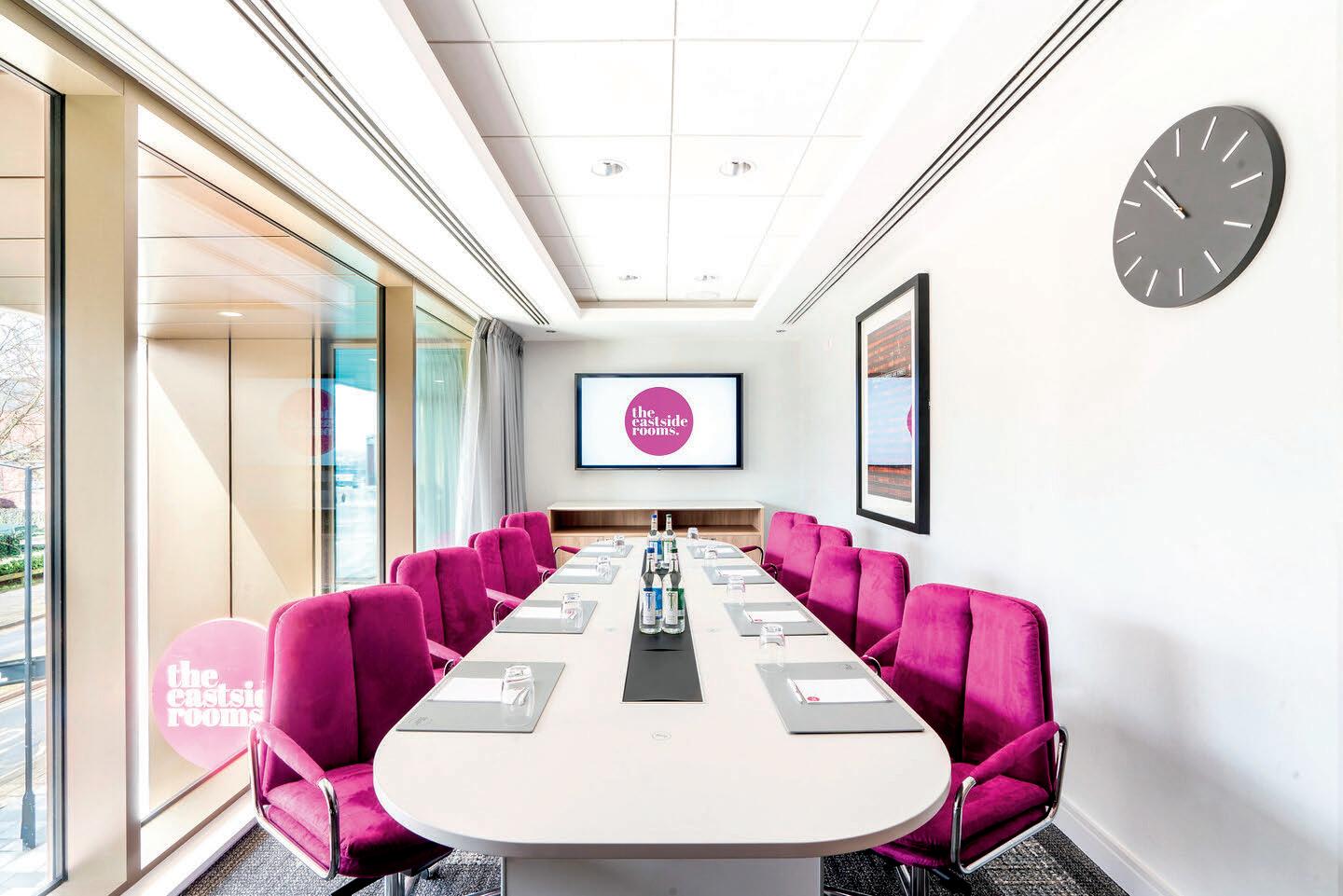


www eastsiderooms com 0121 820 6060
events@eastsiderooms com

Part of the Marriott family the hotel boasts 195 guest rooms, a cocktail lounge and 120 seater restaurant
⇒ 195 bedrooms

⇒ 2 suites
⇒ Gym
⇒ W xyz Cocktail Bar
⇒ Tempo! Restaurant
www aloftbirminghameastside com 0121 820 6000


reservations@aloftbirminghameastside com


The UK has a target of being net zero by 2050. With the deadline approaching, how can the events industry play its part and how can you run a net-zero event?

The government’s Net Zero Strategy: Build Back Greener sets out policies and proposals for decarbonising all sectors of the UK economy to meet the target of net zero by 2050.
Published in October 2021, the plan states: “People are rightly concerned, with the latest IPCC report showing that if we fail to limit global warming to 1.5°C above pre-industrial levels, the floods and fires we have seen around the world this year will get more frequent and more fierce, crops will be more likely to fail, and sea levels will rise driving mass migration as millions are forced from their homes. Above 1.5°C we risk reaching climatic tipping points like the melting of arctic permafrost – releasing millennia of stored greenhouse gases – meaning we could lose control of our climate for good.
“But the good news is that there is, still, a path to avoid catastrophic climate change.
The science could not be clearer: by the middle of this century the world has to reduce emissions to as close to zero as possible, with the small amount of remaining emissions absorbed through natural carbon sinks like forests, and new technologies like carbon capture. If we can achieve this, global emissions of greenhouse gases will be ‘net zero’.
“Delivering this requires urgent global action, including ending coal fired power generation, retiring petrol and diesel engines from all cars, and halting deforestation.”
While it is clear that net-zero should be a priority, how can this be achieved in the events industry? The Net Zero Carbon Events initiative is an industry initiative to address climate change. The initiative states: “The events industry has a special role to play in tackling climate change. We provide the meeting places and market places
to work on solutions to the climate crisis. At the same time we have a responsibility to minimise our impact on climate change.”
Pledge
Phase 1 of the initiative was the development of the pledge, which ran from July to November 2021. The Pledge was officially launched at the UNFCCC COP26 meeting in Glasgow. At the time of the launch, 109 businesses had already committed to taking action. Signatories of the pledge commit to publish, by the end of 2023, their organisation’s pathway to achieve net zero by 2050 (at the latest). This should also include an interim target to reduce greenhouse gas emissions by 50 per cent by 2030, in line with the Paris Agreement. The signatories pledge to measure and track Scope 1, 2 and 3 greenhouse gas emissions according to industry best practice and report on progress at a minimum of every two years. Signatories have also committed to collaborating with partners, suppliers and customers to drive change across the value chain.
Phase 2 of the initiative was the development of the roadmap, from October 2021 to November 2022. The roadmap was officially released in November 2022 at the UNFCCC COP27 meeting in Sharm El Sheikh. According to documentation, “The Roadmap sets out a common framework for stakeholders to make their net zero journey together.” The roadmap is applicable to and adaptable by individual companies. The focus of the roadmap is on event operators, including organisers, venues and service providers. The roadmap recognises that organisations operate in different contexts, each with different levels of resource and local infrastructure. Therefore flexibility in approaches and timelines is built into the roadmap through equity E
The Netgovernment’s Zero Strategy: Build Back Greener sets out policies for decarbonising all sectors of the UK
Unique meeting rooms with views of the River Thames and London. Our rooms are light and spacious and offer various room layouts to suit all occasions. With a range of audio visual equipment.
Unique meeting rooms with views of the River Thames and London. Our rooms are light and spacious and offer various room layouts to suit all occasions. With a range of audio visual equipment.
Unique meeting rooms with views of the River Thames and London. Our rooms are light and spacious and offer various room layouts to suit all occasions. With a range of audio visual equipment.
Unique meeting rooms with views of the River Thames and London. Our rooms are light and spacious and offer various room layouts to suit all occasions. With a range of audio visual equipment.


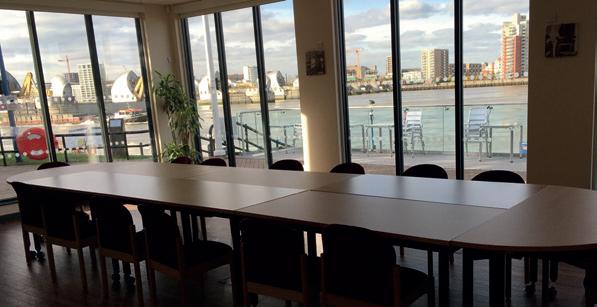






Meeting, event hire for up to 60 people with catering.
Meeting, event hire for up to 60 people with catering.
Meeting, event hire for up to 60 people with catering.
Meeting, event hire for up to 60 people with catering.
Please tephone 0208 305 4188 or email us at Thamesbarriertheview@environment-agency. gov.uk for more details.
Please telephone 0208 305 4161 or email us at Thamesbarriertheview @environment-agency.gov.uk for more details.
Please telephone 0208 305 4161 or email us at Thamesbarriertheview
Please tephone 0208 305 4188 or email us at Thamesbarriertheview@environment-agency. gov.uk for more details.
Please note there is no access on the Thames Barrier Structure.
Please tephone 0208 305 4188 or email us at Thamesbarriertheview@environment-agency. gov.uk for more details.
Please telephone 0208 305 4161 or email us at Thamesbarriertheview @environment-agency.gov.uk for more details.
@environment-agency.gov.uk for more details.


Please note there is no access onto the Thames Barrier Structure.
Please note there is no access on the Thames Barrier Structure.
Please note there is no access onto the Thames Barrier Structure.
Please tephone 0208 305 4188 or email us at Thamesbarriertheview@environment-agency. gov.uk for more details.
Please note there is no access on the Thames Barrier Structure.
Please telephone 0208 305 4161 or email us at Thamesbarriertheview @environment-agency.gov.uk for more details.
Please note there is no access onto the Thames Barrier Structure.
Please note there is no access on the Thames Barrier Structure.
Please note there is no access onto the Thames Barrier Structure.



 Whitefoot Photography
Whitefoot Photography
Whitefoot Photography
Whitefoot Photography
principles. Importantly, the primary aim of the roadmap is to decarbonise the in-person element of events and not to transition to digital or hybrid events as a solution.

The roadmap sets out industry action areas, as well as a company pathway, so it can be used to plan your journey to net zero.
Workstreams
Phase 3 is workstreams to deliver on the roadmap and will run from October 2022 to November 2023. Eight workstreams have been identified to deliver on the priorities that were identified by the roadmap. These are Measurement, Reporting, Carbon offsetting, Venue energy, Production and Waste, Food and food waste, Logistics, Travel and Accommodation. The Net Zero Carbon Events initiative published a “quick guide to getting started”
in February 2022, which sets out the steps you can take for your net-zero journey.
What can you do?
Arguably the most obvious area of focus is energy. Maximise energy efficiency and use renewable energy where possible. Possible actions to take in this area include using LEDs and implementing temperature guidelines to reduce energy consumption. There should be a focus on embedding sustainability and carbon reduction into events.
Food is often not the most obvious focus for net-zero planning, though it is a very easy area to make changes. This can be done by using seasonal and local produce. Food waste should be sorted and can be composted and any leftovers donated. You can discuss sustainable food and packaging with your suppliers and give clear guidelines on your requirements. The next area of focus can be waste. The goal here should be to send zero waste to landfill, this means that full recycling E
Signatories of the pledge commit to publish, by the end of 2023, their organisation’s pathway to achieve net zero by 2050 (at the latest)
options should be available. All equipment and items should be recyclable, renewable or reusable – this includes everything from booths and carpets to lanyards and merchandise. Logistics is another area where reductions can be made. This can be done by working with local suppliers or by using equipment already in place at the venue to avoid the need for shipping. Try to work with venues and service providers to use common and shared materials such as carpet and AV equipment. There should also be an emphasis on consolidating shipments. Finally, travel is often the area with the highest carbon emissions, but the area over which event organisers have the least control. Pick a venue that is easily accessible by public transport and/or that provides EV charging points. Promote sustainable routes to the venue and offer incentives to use sustainable transport. When recruiting staff for the event, look locally to reduce emissions from travel. You should also
provide hybrid options to those looking to attend the event from a long distance.

It is important to establish a net-zero culture in your organisation, so it becomes the norm and staff are always looking for a net-zero solution. Make sure that everyone in your company understands the concept of net zero. Training should be provided for all staff who will be involved as net zero should be a company-wide commitment. All net-zero actions should be taken and discussed in collaboration with your key partners, including organisers, venues and service providers.
It is also a good idea to engage with others in the industry and share best practice, as well as research what other companies are doing.
Every change you make is a step in the right direction and even the smallest change can make a big a difference. Running a net-zero event is not an unattainable goal and there is lots of information available and suppliers out there that can help you with this. L
FURTHER INFORMATION
https://www.netzerocarbonevents.org
All equipment and items should be recyclable, renewable or reusable – this includes everything from booths and carpets to lanyards and merchandise
At The Jockey Club Venues Collection, it’s not just on the track where all the action happens. Known for world-class horse racing, The Jockey Club Venues Collection offers versatile and flexible locations to deliver exceptional quality conference and events throughout the country. You are never far away from one of our 15 venues
at our one of venues or a delegate’s light lunch for 25, we cater for all needs, styles and occasions.
All Jockey Club venues have ample free and on-site car parking, free Wi-Fi and all the latest audio-visual equipment. Our venues are members of BEAM, ABPCO and are AIM Accredited. We are proud to offer a collection of refreshingly different delegate experiences designed to enhance your Jockey Club Venues event. From Segway Forest adventures and footgolf to tackling rickety bridges on the Skywalk Activity course, there’s something to set everyone’s pulse racing across our portfolio of venues. Each of our venues offer different spaces, numbers and options, but they all offer breath-taking scenery and a space steeped in history and prestige.
Why choose The Jockey Club?

Unique spaces for small and large events - indoor and outdoor Conferences and events at the multiaward-winning Jockey Club Venues offer a truly unique experience for delegates and guests alike, we cater for small, large, indoor and outdoor events all with low rates for government business. Our dedicated teams are experts in their field, with experience in organising large-scale outdoor events, corporate meetings and conferences, exhibitions, election counts, training events, team building days, award ceremonies, product launches and lots more.
Our flexible and versatile venues all have several areas and spaces to choose from, making it almost a certainty that a Jockey Club Venue will be a fit for any event criteria.
Whether you need a theatre space for 300
at Exeter Racecourse or a large conference for over 2,000 at The Centaur at Cheltenham Racecourse, Jockey Club Venues are service focused, with a flexible approach and enjoy working with clients to curate the perfect event to meet the event objective. Our fresh, healthy and delicious food is thoughtfully and carefully prepared by our team of exceptional chefs. Ingredients are ethically sourced from local suppliers wherever possible. Impact on the environment is reduced through sustainable produce and practices, waste is minimised, and dishes are seasonal, fresh and balanced with a focus on promoting healthy eating as well as providing choice for those with dietary requirements. We tailor the food offerings to our clients’ requirements, so whether it is a BBQ menu for a team building day using the plentiful outdoor space
The Jockey Club have low government rates and purpose-built conference and meeting facilities for events of all sizes. They also have a dedicated event manager; state-of-the-art AV equipment; free Wi-Fi; award-winning catering with versatile menu options; catering facilities; stunning views with a unique heritage; ample free parking and The Jockey Club is easily accessible by road and rail. Our venues include Aintree Racecourse, Carlisle Racecourse, Cheltenham Racecourse, Epsom Downs Racecourse, Exeter Racecourse, Haydock Park Racecourse, Huntingdon Racecourse, The Jockey Club Rooms, Kempton Park Racecourse, Market Rason Racecourse, Newmarket Racecourse, Nottingham Racecourse, Sandown Park Racecourse, Warwick Racecourse and Wincanton Racecourse.
Get in touch with the team today and find out how The Jockey Club Venues Collection can provide the perfect space for your event. L FURTHER INFORMATION

Call: 01242 539 538
Email: enquiries@jockeyclubvenues.co.uk
Linkedin: the-jockey-club-venues Website: thejockeyclub.co.uk/venues
The Prince Consort Rooms perfectly suits the needs of conference organisers, the largest and most versatile event space at The HAC, it can accommodate up to 400 guests theatre style or 240 cabaret style This bright and spacious room boasts a dedicated entrance – via a pretty courtyard –separate registration area, organiser's office and in summer month’s an outdoor terrace overlooking our five-acre Artillery Garden
The Prince Consort Rooms perfectly suits the needs of conference organisers, the largest and most versatile event space at The HAC, it can accommodate up to 400 guests theatre style or 240 cabaret style This bright and spacious room boasts a dedicated entrance – via a pretty courtyard –separate registration area, organiser's office and in summer month’s an outdoor terrace overlooking our five-acre Artillery Garden
Our comprehensive conference packages encompass all elements of your event, with award winning catering from Searcys, leading technology, LED uplighters and built-in atmospheric lighting, you can be confident that you are receiving the highest possible standards in beautiful surroundings Our team will take care of all your AV and catering needs, giving you the time to focus on your delegates
Our comprehensive conference packages encompass all elements of your event, with award winning catering from Searcys, leading technology, LED uplighters and built-in atmospheric lighting, you can be confident that you are receiving the highest possible standards in beautiful surroundings Our team will take care of all your AV and catering needs, giving you the time to focus on your delegates
Get in touch with our team to start planning your next conference or event today
Get in touch with our team to start planning your next conference or event today

















hac org uk/events
hac org uk/events






sales@hac org uk 020 7382 1533
sales@hac org uk 020 7382 1533


International Confex is taking place at ExCeL London on 1-2 March 2023
According to the organisers, “For 40 years Confex has delivered ideas, inspiration and a meeting ground for the events industry. Over that period, the events landscape has changed beyond recognition and International Confex has evolved with it, from ground-breaking technology, crazy feature builders, wow factor venues, standout destinations to a vivid showcase of all the elements that make events great.”
Conference programme
There are several reasons to visit Confex, such as the conference programme which contains over 150 free-to-attend conference sessions. The conference sessions are specially curated and will see key industry figures share their knowledge, experience, and wisdom.
This year’s conference themes are Sustainability, Marketing Innovation, Event Technology, Sales Excellence, Corporate Events and Diversity & Inclusion.
Sustainability focuses on the realistic and achievable steps organisers, venues and suppliers can take to help with carbon neutrality.
Marketing Innovation recognises that marketing messaging has changed since the pandemic, with the aim of getting audiences back to live events.

Event Technology highlights the advancement in event tech over the last few years and showcases the hottest technologies and innovative solutions.
Sales Excellence is about successful selling, which is sophisticated and demands a highly strategic approach based on emotional intelligence and consultative and collaborative skills to maximise revenues and build business relationships that last a lifetime.
Corporate events will investigate how to create events that are memorable, immersive, engaging and that deliver maximum ROI to business-critical strategy.
Diversity and Inclusion is the final theme and focuses on the importance of diversity and inclusion for success.
Exhibitors
More than 300 exhibitors will be attending the show, including suppliers, venues and service providers. Exhibitors will be demonstrating products and services and launching new products. The show offers the chance to discover inspiration and new ideas and the opportunity to find practical solutions that can be implemented in your own events.
Networking
There are also networking opportunities, with networking events and a networking bar. The networking bar is open to all attendees on both days of the event.
International Confex says: “In extraordinary times, let’s be extraordinary together. Confex 2023 will be where the conversations that shape the next 12 months will take place. Attend one of the many networking events or simply enjoy a drink at the networking bar, catch up with your industry friends and grow your network – that’s what Confex is all about.”
International Confex has a focus on sustainability. Actions being taken include reduced carpeting to limit the amount of waste going to landfill. Attention has also been given to where signage is sourced from, with a focus on recycled materials that can be recycled again post-event.
This year, International Confex has partnered with event:decision to assess the environmental impact of the event. A sustainability report will be published after the event, highlighting areas that could be improved upon.
International Confex said: “Being held accountable for the impact of your events is one of the best ways to instigate change and prompt forward-thinking.”
Attendees are also able to offset their travel to the event and are encouraged to find out the most sustainable way to travel to the event.
Previous attendees have praised the event. Nicola Macdonald, PR director, Montgomery Events said: “International Confex is unarguably one of the must attend events in the exhibition industry calendar and this year was particularly special. It was great to be back meeting face-toface with the who’s who of the industry, reconnecting with old friends and discovering exciting new suppliers. “
Mark Ford, director, Whitespace XPO said: “Each year, International Confex provides us with the ideal opportunity for the continuation of developing relationships with key individuals who are both active and influential within the events industry family - a great place to meet and share our own stories.” L
https://www.international-confex.com/
The conference sessions are specially curated and will see key industry figures share their experience,knowledge, and wisdom


The feeling of togetherness is a great one. We’re committed to to ensuring that we provide the perfect environment for great meetings & events.

Our two residential venues are forward thinking, flexible, and sustainable, providing your team with the perfect space to express themselves. Twin




Futurebuild offers a platform for ideas, solutions and knowledge sharing intended to drive sustainable construction and reach the net zero goal.
Futurebuild’s mission: “Futurebuild is about building a better future for the built environment.
“As the industry’s premier event, we provide the stage for inspiring ideas, innovative solutions and knowledge sharing to drive sustainable construction and help us reach our goal of net zero.
“The exhibition brings together the entire supply chain to showcase, debate and understand the advancements in sustainable construction and the emerging technologies that will make net zero possible. Futurebuild is about driving positive change.”

Futurebuild boasts innovation, showcasing the best products and materials and supporting innovation to help create net zero buildings, more quickly, more safely and more efficiently.
Futurebuild will also be championing sustainability, being committed to ensuring that the built environment is on track to achieving net zero goals and having been driving the sustainability for more than 16 years.
Futurebuild also aims to enable collaboration, bringing the entire supply chain together to generate
The show highlights three values: content; influential; and walk the talk. In practice, content means delivering a carefully curated and expertly delivered speaker programme, with over 300 speakers across ten stages. Futurebuild claims to be the influential leader in terms of built environment trade events, boasting “a stellar line-up of distinguished speakers, the best in class exhibitors and senior decision makers”. Finally, Futurebuild “walks the talk” by leading by example when it comes to net zero. With its roots in sustainability, Futurebuild has the ability to influence and guide the industry on the road to net zero.
Exhibitors and conference programme
Futurebuild features more than 200 exhibitors showcasing their ideas, products and services. View the list of exhibitors here
The 2023 Conference programme focuses on “taking a stand”. This means looking forward, making a change and taking action, with each day focussing
“What will you take a stand for? “We’re taking a stand for a better built environment and are urging companies and professionals throughout the industry to make a similar commitment by ‘taking a stand’ on an issue they passionately believe will help propel the industry towards a more sustainable future.”
There will be seminars on wellbeing, biophilic design, healthy buildings, modular efficiency, creative placemaking and reliability. Other topics include high-quality insulation, building services, biodiversity, Passivhaus and regulations and standards. The spotlight areas this year will be lighting, innovation zone and district energy.
Day 1 of the conference programme will be about looking forward to develop the necessary foresight to break out of our current mindset. Day 2 will focus on making a change, in particular, behaviour change. Questions will be posed such as ‘what does the necessary transition involve? and ‘how can we bring others along with us?’
The final day will cover taking action and will feature speakers who have already taken action, as well as explore plans that can move the construction industry forward.
Visiting
Futurebuild is free to attend and easily accessible by public transport.
Futurebuild says: “Futurebuild is taking a stand for a better built environment and we want you to join us. By getting involved you will drive positive change for your industry, whilst connecting with like-minded people and the innovations that will propel the industry towards a more sustainable future”. L
FURTHER INFORMATION
Access our end-to-end connectivity service, delivering fibre directly into the premises of central Liverpool businesses
Capacities of 100Mbps to 10Gbps, with guaranteed access to the fastest possible routes
Access to our full product set including, Ethernet, Optical Wavelengths, Dedicated Internet Access and SD-WAN
Critical national infrastructure provider with three Network Operation Centres 24-hour support, 365 days a year
Instant quoting and ordering via our online pricing tool, LIVEQUOTE

34,000km private UK telecoms network 90+ commercial data centres on-net 550 unbundled exchanges including newly added Liverpool Royal and Liverpool Central
There’s no doubt that high-speed internet connectivity forms the foundations of hybrid working and blended learning. It helps power our businesses, educate our children and unlock career opportunities. Yet behind the discussions about levelling up, there’s a lot to achieve to truly end geographical digital inequality across the nation?
towards a potential failure to deliver on its promise of providing affordable solutions for rural areas and remote towns and villages. There’s also another reason for the slow progress. Not all potential suppliers of connectivity infrastructure are treated equally by existing planning legislation.
A lot can (and has) happened since February when the government published its levelling up whitepaper.
The whitepaper acts as a framework to end economic and social digital inequality across the UK. It aims to boost economic growth, enhance educational attainment and restore the social fabric of those parts of the UK that have stalled.
The pursuit of geographical and digital equality
High-speed connectivity plays a pivotal role in ending geographical and digital inequality, it is the backbone that supports economic dynamism and innovation. With hybrid working and blended learning programmes looking set to stay, it is necessary to shine a spotlight on connectivity shortcomings and expose the extent of the UK’s digital divide.
Yet connectivity and mobile infrastructure issues are surprisingly scant within the government’s whitepaper, covering just three of its 332 pages. However, it’s not all bad news. As the whitepaper points out, back in 2020, the government committed £5 billion in public funding to deploy gigabit connectivity across at least 85% of the country by 2025. Something we and our partners are actively striving to support.
Often referred to as the AltNet fund, this money was seen as a pledge to support the delivery of gigabit networks across the 20% of the country that is most difficult to reach.

The essential role of AltNets
AltNets, or alternative network providers, are independent telecommunications companies building out their own networks (as well as relying on the networks of others, like ourselves). They offer high capacity

fibre connectivity services to UK residents, competing against the two large incumbents, Openreach and Virgin Media. There’s been a groundswell of AltNet activity over the last few years, much of which has been focused on typically underserved regions of the UK. With many AltNets locally focused, we’ve been working in partnership to extend both their reach and their capacity options. They rely on our exchange backhaul services, to connect into our wider UK network, giving them access to better, more reliable connectivity at the speeds being demanded of their surrounding residents.
We recently announced that we’re launching our first access network, bringing high capacity end-to-end connectivity to four key business hubs across the UK, Liverpool, Birmingham and Manchester and London. This full-fibre, last-mile investment will help regionally based businesses and offices keep pace with their national and international competitors. It goes a long way towards our aim of bringing high capacity 100Gbps connections within reach of more UK businesses, as well as facilitating the rollout of advanced 5G services and other next-gen technologies.
A January report by the Public Accounts Committee suggested the government is over-reliant on Openreach and Virgin Media to deliver the nationwide connectivity solution. The report found that the two telecom giants are focused on the less costly, easier to reach urban conurbations, leading the government
In December last year, the House of Commons Library published a research paper, Building Broadband and Mobile Networks, which outlined for MPs the current challenges and legislative framework covering how networks are built, including planning requirements and access agreements. The incumbent national communications network operators have permitted development rights. This means they can install roadside broadband cabinets, build mobile masts or erect telephone poles without the need to obtain planning permission. For other companies, there are barriers that are delaying their ability to build that infrastructure at the speed needed to meet the government’s targets. Obtaining those access agreements and wayleaves is often difficult and long-winded, with the process sometimes taking up to two years.
There is a clear and present need to move beyond the usual national suppliers. This has been emphasised by the £5 billion AltNet fund. It seems that when it comes to levelling up, this fairness of play should apply to the challenger companies in the telecoms infrastructure supplier community as well. Levelling the supply playing field will help to accelerate the gigabit rollout and advance the government’s plans. In the meantime, we’ll continue to work with the AltNets, assisting in high capacity fibre network deployments that connect communities and boost regional businesses. Will levelling up become an achievable, balanced and sustainable reality? We certainly hope so. And Neos Networks will be there every step of the way. L
UK Cyber Week – Expo & Conference is taking place at the Business Design Centre, London on 4 and 5 April 2023
The term “sophisticated cyber-attack” has become an industry buzzword in recent years. Depicting the malicious actions of online attackers in this light portrays businesses as the plucky underdog in the fight against the bad actors of the internet.
Denying the existence of higher attack sophistication would be imprudent. However, to label the majority of attacks as such would be equally incorrect. When discussing this matter, it is important to look at what sophistication actually means, why describing attacks as such has seen a recent surge and how we can help curtail recent increase patterns.
How sophisticated are modern cyberattacks?
There is no denying that ransomware has grown significantly as an issue in

recent years. Attack numbers have risen dramatically since the COVID-19 pandemic, with remote working conditions opening up new gaps in security measures. In fact, reports suggest that ransomware attacks have risen by an astonishing 600 per cent since the pandemic. While attack quantities are undoubtedly up, it is difficult to definitively state whether attacks have become more sophisticated or not, without determining exactly what we mean by this.
The notion of increases in sophisticated cyberattacks emits connotations of a new breed of threat that has evolved from its predecessors. However, often even the most archaic techniques open up holes in organisations’ defences. It is in the attacker’s approach and delivery that the sophistication lies.
In 2021, Australia’s Channel 9 News fell victim to a ransomware attack that disrupted the delivery of the channel’s regular broadcasts. Not only did the attack prevent the station’s ability to air its shows as per usual, but the entire team was also blocked from their emails and denied access to the internet. It later transpired that this large-scale cyber-attack occurred as a result of a simple phishing email.

Phishing is a prime example. The act of fraudulent online imitation in order to draw information from other internet users, this attack strategy has existed since the 1990s. Back then, attackers imitated AOL administrators for login credentials. This would eventually evolve into a popular means of exploitation via email, as per the Channel 9 attack. Recently attackers have utilised other means of contacting their victims, including WhatsApp and LinkedIn Not a change in substance, but a change in style.
This style of change in tact doesn’t necessarily denote sophistication. Yet, still, it is often labelled as such. The term is often used as a means of insinuating that there was nothing that could be done to prevent it. Painting the organisation as the plucky underdog facing a superior adversary. This in turn garners sympathy and helps preserve the company’s image.
As with most elements of online activity, many recent trends are heavily influenced by real-world actions. The COVID-19 pandemic is frequently referenced as having a significant impact on cybersecurity matters. As with many elements of society, this needs to effectively down tools and adapt quickly to the alarming infection rates of the virus left by previously
sound policies exposed. This was an unforeseeable situation dramatically exploited by malicious online actors. And with it came a tidal wave of attacks. Beyond the indomitable changes in ransomware quantity following the coronavirus situation, the most influential factors fall in the lap of the workforce itself. 95 per cent of modern cybersecurity breaches are caused by human error. Combine this with the fact that almost half of the organisations failed to provide training on the potential threats to remote work, and it becomes clear that failures in preparation are a significant factor in the success of allegedly sophisticated attacks.
One must also consider the coverage around attacks in this modern era, outlining their potential for causing chaos to the entire planet. In 2021, the system at a water treatment plant in Florida was attacked, with the perpetrator increasing the levels of lye in the city’s water - a move that could cause danger to human life - before exiting the computer. The extreme potential consequences of the attack saw it deemed “sophisticated”. But it is also important to note that the attacker initially entered the system due to poor password hygiene and out-of-date software.
With recent global events like the RussiaUkraine conflict sprouting a slew of reports on increasing numbers in cyber-attacks, it is easy to see why many associate this with an increase in the sophistication of these threats. However, some argue that it is a stalling in defences rather than a step forward in modern attack methods that has caused this surge.



Some cyber attackers are sophisticated, but the vast majority are not so, if the attacks are not sophisticated, then where does the responsibility lie? Typically, as previously

shown, they are the result of lacklustre training and preparation, poor defence strategies or improper funding of cybersecurity teams.
In its most fundamental terms, these issues share one feature in common - human error. Combatting this colossal modern security issue starts with the adoption of a zero-trust approach and the installation of meaningful training. This incurs tighter controls around data, reducing the chance of any unauthorised access and having your team prepared to act swiftly and correctly in the event that these policies do fail.
If you are interested in the modern development of cyber threat sophistication and how to prevent your enterprise from falling victim to it, make sure to attend UK Cyber Week – Expo & Conference on 4-5 April 2023 at the Business Design Centre, London. Our speaker sessions include 100+ cyber security experts, hackers and disruptors with perspectives from across the industry. L
Find out more and get your free tickets here
●
●
●
●
●
●
●






 By Ian McCormack, NCSC Deputy Director for Government Resilience, and Emily Mayhew, DLUHC Cyber Policy Lead
By Ian McCormack, NCSC Deputy Director for Government Resilience, and Emily Mayhew, DLUHC Cyber Policy Lead
Cyber security in local government is an exciting place to be right now. Collaboration is the watchword, and the sector has no shortage of supporters committed to helping councils become more resilient to online threats.
The public sector has made progress with cyber resilience in recent years but sadly, we know that cyber attacks do still get through, with costly consequences. These incidents show that more can be done across the sector, and this creates real opportunities for joint working, prioritisation, and problem-solving.
Standing shoulder-to-shoulder with councils is the National Cyber Security Centre (NCSC), the UK’s technical authority on cyber security, which works closely with the Department for Levelling Up, Housing and Communities (DLUHC) as well as their devolved government counterparts to support local authorities across the UK.
Through a range of activities and initiatives, we are helping councils meet the demands of a modern, secure, and resilient digital future. This means supporting them to put measures in place to boost their defences and to plan their response should they fall victim to a significant incident.
As highlighted in the NCSC’s latest annual review, cyber criminals pose a significant threat to the UK public sector and successful attacks can have severe impacts on an organisation’s ability to deliver key services, its finances and reputation. Ransomware is one of the most acute threats the UK faces, and we urge all organisations to follow NCSC guidance so they can protect themselves.
Local authorities are no exception and recent high-profile incidents have highlighted the direct impacts but also the fortitude needed by staff to respond and recover in the longer term.
Councils continue to build their capacity and capability but in the face of these evolving threats, there are some actions local authorities can all take to strengthen their cyber security posture right away.
Signing up for the NCSC’s free Active Cyber Defence (ACD) services is a great next step and many public sector organisations have done so and are enjoying the benefits already. There are a range of tools available which aim to help reduce the harm from commodity cyber attacks and build upon good cyber resilience.
This includes the Early Warning service, which has been well-received by council network defenders since its launch last year. This growing service helps UK organisations investigate cyber attacks on their network by notifying them of potentially malicious activity and, across all sectors, the total number of users almost doubled in the year to September 2022. We strongly encourage councils to sign up for these tools and recommend keeping an eye out for the new internet scanning capability, which will help the NCSC better understand the sector’s E
islocalsecurityCyberingovernment an exciting place to be right now
vulnerability to cyber attack and improve council system owners’ awareness of their security posture on a day-to-day basis.
Understanding
Good cyber resilience is not all about ‘tech’, however; it is also about people and improving understanding about cyber security so everyone can play a part in keeping an organisation safe. The NCSC has a range of advice to help with this.
Local authority CEOs have welcomed the Board Toolkit resources, including specific advice on ransomware, as well as Exercise in a Box, which helps organisations test how resilient they
are to cyber attacks and practise their response in a safe environment. These resources are designed to prompt discussion between Information Technology professionals and senior decision makers to help embed and sustain a shared understanding, and collegiate approach, to cyber security. Enabling clear and honest dialogue about threats, risk appetite, prioritisation and investment is key for effective risk management to help identify and address vulnerabilities.
We find the best approach to improving cyber resilience is a collective one. Cyber security is a

team sport and government, law enforcement and sector representative partners are all on side to support local authorities. One of the key partnerships for the NCSC exists with DLUHC. As the department responsible for overseeing local government in England, DLUHC has been instrumental in strengthening the sector and is working with local authorities to translate the ambitions of the Government Cyber Security Strategy into pragmatic, scalable and sustainable solutions.
The DLUHC Local Digital Team’s mission centres on helping councils build the digital public services of the future. Following the launch of the Local Digital Declaration in 2018 and more recently the Local Digital Fund, there has been a significant shift towards local government using more modern, user-friendly services based on flexible, secure technology. Alongside exploring the possibilities created by new technologies, the team is helping councils manage and mitigate the new and evolving risks that can come alongside them.
Since 2020, more than 180 local authorities have put bespoke Cyber Treatment Plans in place to mitigate against security risks
Following the launch of the Local Digital Declaration in 2018 and more recently the Local Digital Fund, there has been a significant shift towards local government using more modern, user-friendly services based on flexible, secure technology
and vulnerabilities, with help from the DLUHC Local Digital team’s Cyber Support programme and more than £19m is being provided to fund interventions. The work has included a focus on ensuring councils have effective offline backups in place, in line with NCSC best practice, as this is a critical factor in how rapidly an organisation can recover from a ransomware attack.
DLUHC is also developing a clear cyber security baseline for local authorities, based on the NCSC’s Cyber Assessment Framework, which will give councils a comprehensive way to assess the extent to which they are managing cyber risks to their essential functions. It encourages users to reflect not only on technical aspects, but on governance, people, and process too.
The team has been working closely with ten councils this autumn to test how the framework should be applied within a local authority context. The project so far has explored questions around the scope of the assessment, the challenges, and opportunities for councils, and how to set a proportionate baseline. The project will also consider what reporting requirements and external validation should look like in the future. Updates and learning are
being shared through the DLUHC Digital blog and events as this work continues.
DLUHC is also driving forward new initiatives to tackle more entrenched, common digital and cyber challenges across the sector, such as how to modernise critical services delivered by councils.

Over the next few years the Future Councils programme will explore these types of questions, and will enable councils to trial ambitious digital and cyber improvements across their organisations, reform key services, and influence organisation-wide factors that can unblock change for the wider sector. The first pilot cohort will be announced by DLUHC in early 2023.
More information can be found on the DLUHC Local Digital website or for those working
in local government cyber security, we encourage you to consider registering for a place at the CYBERUK 2023, the UK’s flagship cyber security conference run by the NCSC which will take place in Belfast in April.
The theme of the conference is ‘securing an open and resilient digital future’ and it presents a terrific opportunity to collaborate and share ideas. It is through working together and making connections that we can help to keep councils, and the wider UK at large, safe online. L
DLUHC is also driving forward new initiatives to tackle more entrenched, common digital and cyber challenges across the sector, such as how to modernise critical services delivered by councils
The Counter Fraud conference returns in February for its 12th iteration, bringing together fraud, finance and audit professionals from across the public sector. This awardwinning event fosters learning, discussion and collaboration across central and local government organisations to strengthen the UK’s resilience to fraud. This year we welcome the launch of the PSFA and the changes this will bring to the Fraud Profession, we look at upskilling across the sector to meet new challenges such as Cyber Fraud, and we discuss learnings from Covid-19 and how they can be applied to ensure the new cost of living support is protected.
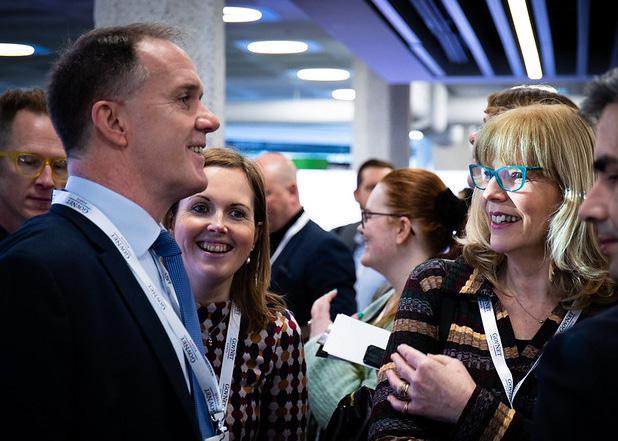
“A relevant and rare opportunity for the fraud community to meet up and learn about the current issues and latest trends relating to fraud” - counter fraud officer, Home Office
The launch of PSFA
Summer 2022 saw the launch of the Public Sector Fraud Authority (PSFA), eagerly awaited by the sector to help drive the fraud defence forward. As they continue to grow, fraud professionals are keen to understand this new layer of support and how they can use it within their organisations to strengthen fraud resilience. The event is produced by GovNet in close collaboration with the PSFA to ensure the content aligns with sector goals and that we’re providing attendees with
the most up-to-date knowledge, resources and contacts to fight fraud effectively.
Mark Cheeseman, OBE, interim chief executive of PSFA returns to share his expertise as our keynote address, and chairman. His presentation will be one of the first given since the launch of PSFA and we’re excited for him to share the vision on modernising the fraud and error response. Another battle for fraud professionals, and a focus of the PSFA, is building capability; including career pathways and the new Counter Fraud Leaders Programme.
Laura Eshelby, deputy director, practice, standards and capability, PSFA, will cover the journey so far and the objectives for the counter fraud profession. Understanding what our international counterparts are achieving is becoming more and more important with evolving fraud types. Being able to work closely together to prevent fraud on a global level is a huge goal to work towards. Rob Malcomson, deputy director of policy, PSFA will share insight from working with the international teams. Alongside this we also have presentations covering Development of the National Counter Fraud Data Analytics Service and a workshop with the Digital Economy Act team, detailing how easy it can be for central government departments and local authorities to share data
and collaborate on fraud cases, with the right knowledge of the system.
Unfortunately, we’re all too aware that we’ve been living through a series of unprecedented times, putting strain on the entire country. The UK government has continued to step in and support, but with this support it has opened the public purse to an increased level and a new diversity of fraud. We’re still looking to understand the impact of Covid-19 support loans, the fraud encountered as a result of the pandemic and associated levels of debt that arose; but the UK has continued to learn and increase our fraud defence which can now be applied during the cost-of-living crisis that we’re facing. It is with this accumulative and collaborative learning that we’ll continue to adapt and improve our defences, ready for any future crises that may arise.
We’ve invited experts across the public sector to join us for insightful discussion on what we can and are doing in this space. Hear from; Laura Higgins, deputy director counter fraud, BEIS, Rob Malcomson, deputy director of policy, PSFA, Rob Jones CBE, director general, National Economic Crime Centre, National Crime Agency and Simon York CBE, director, HMRC on how to ensure resilience within our fraud defence, and how both central and local government can best protect themselves from fraud and economic crime.
Do we really know the extent of the threats and the costs associated with fraud in the UK? We’ve invited Joshua Reddaway, director of counter fraud and corruption, National Audit Office to give an update on the scale of fraud against the taxpayer, as well as practical advice about the changes that are needed by government departments to build their counter fraud capability, to modernise their approach and to adopt best practice. It’s estimated the public sector loses £33bn a year to fraud and error. More and more we hear of a shift in focus to fraud prevention, to help us better protect the public purse. Creating a more proactive approach to fraud and risk will ensure that we lose less money; however it can be difficult to understand the true value of being proactive as we can’t accurately quantify how much money is NOT lost throughout the year. For this reason, we have invited Chris Keesing,
With new and innovative ways to de-fraud the public sector it’s important to keep up to date with the risks, de-mystify threats and understand how to protect and prevent attacks
counter fraud & investigations manager, City of London Corporation & Chair, London Borough Fraud Investigators Group, Lauren Ashdown FCCA, ACFS, audit manager, Internal Audit & Corporate Fraud Services, Ipswich Borough Council, Marc McAuley, senior counter fraud consultant, CIPFA and Mark Astley, head of NAFN Data and Intelligence Services, National Anti-Fraud Network (NAFN) to share their experiences of fraud prevention and their success stories in reducing or stopping high levels of fraud.
What are some key threats?
‘Fraud’ and ‘Cyber Security’ seem to be used hand-in-hand recently and Cyber Fraud is on the rise. We’re all keen to understand the associated risks of Cyber Fraud and how we can protect ourselves and our organisations against the number of threats and attacks the public sector receives. Luckily, the number of positive stories within the industry is fantastic and we’ll be sharing take-home tips on how to determine ‘real’ vs ‘fake’ cybercrimes, plus advice on encouraging IT teams to work closely with Fraud, Audit and Risk to understand the mitigations in place. Fraud doesn’t only come from outside threats either. How well are we protected from hiring fraudsters? It’s sometimes difficult to determine who may be trying to de-fraud your business, and a scary statistic is that fraud often comes from individuals within the organisation.
Claire Maillet, head of financial crime operations, Ziglu shows us what steps can be taken to prevent insider fraud, especially in the modern world of remote working, which opened us up to more attacks of this sort than ever before.
Given the scale of fraud and economic crime within the public sector, and the amazing work done across the industry, it’s well worth celebrating the success stories. We’ve chosen to highlight a case study on adult care
fraud on the Counter Fraud 2023 conference agenda, with Nick Jennings, head of service, Shared Anti-Fraud Service, Hertfordshire County Council outlining how the case was investigated, and how they achieved prosecution in court. He’ll also be sharing lessons learnt, so that others can better protect their organisations in the future. As the curtains close on the conference for 2023, we’ll be putting success in the spotlight. The 3rd annual Public Sector Counter Fraud Awards reward the spirit of innovation, dedication and great teamwork that we’ve seen these past 12 months. We received a staggering number of entries this year and it’s both humbling and inspiring to see what the sector has achieved. Run in collaboration with the PSFA, winners in each of the eight categories will be announced at the Gala evening, hosted by Lyn McDonald OBE, director, Cabinet Office. Taking to the stage this year will be worthy winners from: Public-Private Partnership Excellence; Risk Prevention Initiative; Local Excellence; Apprentice or Newcomer of the Year; Diversity and Inclusion; GCFP Member of the Year; Team of the Year; Fraud Leadership. It will be an unrivalled day of collaboration, knowledge-sharing, celebration and partnership for the counter-fraud sector and we cordially invite Government Business readers to join us.
Join us on 22nd February at the QEII Centre, London for the Counter Fraud Conference


2023. Previous events have enjoyed great success, going on to win the Best Development of an Existing Conference award at the Conference & Events Awards 2022. You’ll be networking with 350+ attendees from senior roles, including thought leaders, decision makers and innovators across central and local government and the wider public sector. “A thoroughly well organised and important event for all counter fraud specialists” -
Alex Rothwell, CEO, NHSCFAThe event is followed by an evening of celebrating achievements at the Public Sector Counter Fraud Awards. These prestigious awards align with the new PSFA pillars and highlight some of the fantastic work done by our colleagues and peers in tackling fraud.
The day’s agenda is jam-packed with keynote sessions, interactive panels, thought-leadership seminars, and practical case studies. Our interactive session formats enable you to network with like-minded colleagues, share resources and collaborate to create sustainable fraud prevention and detection plans. Tickets are available now. Government Business readers from the public sector get an exclusive 30% discount, using code: FRAUDPSI30. Register your place today: https://hubs.la/Q01x26_p0
View the full agenda: https://hubs.la/Q01tXRDp0 L
Having missed out on being European Capital of Culture due to Brexit and losing out in the bid to host Eurovision, in 2023, the city of Leeds is hosting a year of cultural celebrations


Leeds Year of Culture 2023 will be running partnerships and events to promote culture in the city. The project will aim to unlock opportunities for everyone to find enjoyment and live their best life through participating in creative activity; boost engagement in culture particularly among people who face barriers because of their experience or circumstances; lead and showcase cultural transformation and play an active role in the city and region’s social, economic and cultural recovery from the pandemic.
Tracy Brabin, mayor of West Yorkshire said: “LEEDS 2023 is an exciting year of culture that will show the world everything this fantastic city has to offer. “We know that our creative talent rivals anywhere in the country, and LEEDS 2023 will give people a fantastic opportunity to express themselves, all while boosting our local economy.”
“It’s important that we’re also
empowering women and girls across our region, giving them the tools to get into work or change careers with boot camps to share and learn construction skills.”
LEEDS 2023
LEEDS 2023 is run by the Leeds Culture Trust, an independent charity set up in 2019 by Leeds City Council as part of its Culture Strategy and as a response to the cancellation of the UK’s participation in the European Capital of Culture competition, following Brexit. The event is supported by Arts Council England and National Lottery Heritage Fund. Councillor Jonathan Pryor, Leeds City Council’s executive member for economy, culture and education said: “We’re absolutely thrilled to be supporting LEEDS 2023 and to be seeing this hugely imaginative and exciting programme of events taking shape across the coming year. “Culture has a unique ability to both enhance and empower our communities, giving them the platform to showcase exactly what makes Leeds such a special place. It also makes a massive contribution to our local and regional economies, attracting visitors, businesses and inward investment.
“We can’t wait to be part of what will be a transformative celebration of culture, creativity and innovation in Leeds.”
Leeds 2023 states as its vision: “A thriving, exciting and inclusive Leeds. Where creativity fuels opportunity. For everyone.” and its mission is “to deliver a year of creative experiences which connect people and change their relationship with culture for good.” The project has four values: Compassionate: “It’s with a huge heart that we’ll look out for each other, knowing we’re stronger together.” Bold: “Together, we know our spirit, imagination and creativity will make a positive difference to thousands of lives.” Confident: “With a team we trust and people who can both inspire and be inspired, we can achieve amazing things.” And finally, Inventive: “The rule book has gone; ripped up and thrown out in favour of fresh thinking, brave ideas and new ways of doing things.”
The year began with a kick-off event called The Awakening at Headingley Stadium. Hosted by Gabby Logan and Sanchez Payne, the event featured live performances and appearances from Corinne Bailey Rae, Simon Armitage and LYR, The Orchestra and Chorus of Opera North, Graft, Inder Goldfinger, Testament, Hope and Social, Jamie Jones-Buchanan, Denmarc Creary, and George Webster. Attendees exchanged artwork in return for tickets for the event and these artworks will be displayed in a pop-up exhibition across the city from January to April. Several events, activities and exhibitions will be taking place across the city throughout the year.
The WOW Barn, created by WOW - Women of the World Festival Founder Jude Kelly CBE, is a temporary structure on Cinder Moor, which will host two weeks of discussion, music, performance and workshops. Applications for Barnraisers (300 women and non-binary people to help raise The Barn) are open now.
Leeds Literature Festival will hold a special edition on the themes of untold stories, radical acts, playful adventures and future generations from 25 February to 5 March. Events at Leeds Literature Festival include a workshop from Dan Coxon on “Weirding Your Fiction”, live poetry reading from Lemn Sissay and others and A Day in the Life of an Astronaut with Mike Barfield. Several events will be free of charge, including an All-Night Readathon at Chapel FM Arts Centre and a screening of The Magician, a new film from James Phillips featuring a dystopian vision of Leeds. There are also several family events including Lego building and learning how to code robots. Author and illustrator Sharon Rentta will be talking about space with Stella the Squirrel and Sophie Deen will be sharing her latest Asha Joshi book.
The Leeds 2023 Creative Learning Programme aims to give children and young people a chance to take part in the Year of Culture. The programme includes classroom resources, facilitated workshops, participatory activities, and opportunities for learning outside the classroom. Learning resources are available such as classroom resources, facilitated workshops, and school trips, which map to subjects in the National Curriculum, are inclusive for learners of all abilities, are free to download or participate in and enhance the development of cultural capital. Key Stage 1 resources include Indie and Punk Music in Leeds and the History of the Leeds Rhinos, with Leeds Men’s captain Kruise Leeming. A culture map is available, showing where all the events will be taking place.
Neighbourhood hosts
33 Neighbourhood hosts – one for each ward - will be highlighting Leeds communities. The hosts will be meeting every week and participating in training workshops, trips and discussions. They will be exploring their wards, finding out what
makes them special and highlighting the creativity and culture within them. The hosts will also be helping residents take part in the opportunities of Leeds 2023.


Kelly Hamilton, Gipton & Harehills
Neighbourhood Host said: “I want to give back to and inspire my rich and warm community, by lifting and celebrating the vibrant and diverse voices that dwell here.”
Caroline Newsome, Garforth & Swillington
Neighbourhood Host added: “Having the opportunity to be involved in creative activities can have a transformative impact on people’s lives and I’m so excited to be a part of this outstanding project.” Local residents are encouraged to take part by volunteering, to make connections, get a culture boost and discover opportunities to grow. Locals can apply online.
First Bus has also partnered with the festival to promote sustainable travel. A bright-pink, ultra-low-emission bus will be running around Leeds over the next year to promote the project.
John Godfrey, head of marketing for first bus in West Yorkshire said: “We’re delighted to partner this 12-month celebration of cultural events, diversity and attractions across the city. The bus will be used on routes throughout Leeds so we’ll help to get the message into communities. Travel for leisure, social and entertainment activities has come back strongly and we’re looking to build on this behaviour and welcome more customers through the year.
LEEDS 2023 will create opportunities to explore and discover new experiences and
we share in the ambition of the organisers to encourage the people of Leeds and visitors to use sustainable travel to get there.”
Kully Thiarai, creative director and CEO, LEEDS 2023 said: “With the kind support and the true Yorkshire grit of the whole city, along with the help of partners, colleagues and peers, from the very local to the global, we have together dreamed up a year of creativity that we hope will provide much needed joy, delight and extraordinary experiences for everyone.
“Our Year of Culture is designed to wake up our senses and reveal our city in brand new and surprising ways; in ways perhaps that you never expected or noticed previously. We know that when this city speaks it has a proper story to tell. And it is our ambition to be the spotlight and foghorn for all the glorious creativity that is behind every door, in every home: broadcasting the brilliance of Leeds beyond the region and to all of us who live and work in the city.” L
FURTHER INFORMATION
https://leeds2023.co.uk
Veolia is a trusted market leader in Utility Facilities Management (FM), offering an extensive range of services to support local and central government, designed to improve the environmental performance of your property.

Our commitment to providing high quality Utility FM services has been recognised, and we have been named as a supplier on Crown Commercial Service’s Facilities Management and Workplace Services frame (Lots 2a and 2b).

To discuss our extensive range of FM services visit www.veolia.co.uk

Veolia is a trusted UK leader in resource management. We offer a full range of utility FM services, from energy and water management to building fabric maintenance and mechanical and electrical maintenance services. Our commitment to providing high quality utility FM services has been recognised, and we have been named as a supplier on Crown Commercial Service’s Facilities Management and Workplace Services framework

On average, our services deliver scope 1 and 2 carbon savings of 20 per cent and cost savings of up to 30 per cent in year one. We achieve this through the delivery of sustainable waste, and water solutions, and offering cost effective energy solutions to decarbonise your estate. Ecological transformation is our key focus and goes beyond just the solutions to being an active partner in helping you understand how your building impacts your carbon footprint by using innovative monitoring technologies. Find out more about Ecological Transformation in our explainer video
How could a partnership with Veolia benefit your business?
Veolia understands that every building is different, and managing your estate can be challenging but understanding your energy and FM requirements shouldn’t be. A collaborative partnership with Veolia will deliver real results against your carbon footprint in year one. We will take the time to get to know what your needs are and adapt our approach. We can even embed our employees with environmental knowledge and experience directly on to your site - a fairly unusual approach, but one that ensures we understand your objectives. Working with Veolia means you will have access to industry-leading data analytics and an FM-trained Account Management team that speaks your language.
Unlock your potential - What solutions can Veolia offer?

We can support you in identifying areas of carbon savings to develop a carbon reduction strategy, and choosing the best solutions and technologies. You need to find ways to decarbonise your building that are cost effective, fit in with existing infrastructure and cause minimal operational disruption. Veolia can support you to look into options such as zero carbon and hydrogen fuels, to help you innovate and prepare your building’s power, heating and cooling demands for a less carbon-intensive future.
While others are planning, Veolia is delivering
We are at the forefront of innovation. In the fight against climate change, we help
Veolia is a trusted market leader in Utility Facilities Management (FM),






A well planned, connected lighting solution can significantly reduce your carbon footprint and energy use - by up to 80% vs traditional sourceswhilst also reducing operational and maintenance costs. Helping you to save money whilst supporting your drive to net zero.









Combined with our luminaires Schréder EXEDRA is your logical choice.














In
issue’s
Urbis Schréder
Gary is an accomplished strategic thought leader driving technology and service solutions across multiple local authority and private city applications.



Working across industries and geographies in global product marketing and currently as managing director for Urbis Schréder, he has launched Logic which combines intelligent and scalable lighting solutions to openly and interoperably connect a city with spaces, assets and communities.
Urbis Schréder
Still passionate about lighting after 25 years within the wider industry, Clare joined Urbis Schréder in 2019 to help define and deliver their connected strategy through their Logic approach. Using her long track record in delivering major and connected projects for lighting manufacturers, controls companies and from the client perspective, Clare and her team take a holistic through-life approach rather than selling a product or technology. Working collaboratively with local authorities and other stakeholders they look to deliver smart, connected and sustainable solutions that help create spaces and places people love to be in.
This experience was used to develop the white paper and CPD on ‘Dark Skies or Safer Streets’, which Clare originally wrote to start a debate around how we light our spaces and places. As well achieving that, it has also meant Clare is now actively participating in lighting strategy, safer streets initiatives, green infrastructure projects and other related smart solutions across the public realm.

Urbis Schréder
Phil has worked for Urbis Schréder in a sales capacity for the last 30 years dealing with local authorities, consultants, contractors and end users. Working across the exterior lighting arena, he has been involved in delivering numerous high-profile projects covering all forms of exterior lighting. Digital connected lighting is the way forward with a major focus on energy conservation. Phil is instrumental in driving this strategy along with his team for Schréder.
Good lighting is well-known to reduce crime and improve safety on the streets, we asked the panellists why good lighting was so important. Gary said: “Good lighting can have several impacts to safety on streets. With the correct design and quality of the light distribution you cannot only provide the feeling of safety, thus attracting more people to that area but also provide users with the ability to see the way ahead and opportunities for alternate routes and refuge should there be a need to.” However, Clare has a slightly different opinion: “I’d maybe disagree that lighting on its own helps reduce all types of crime, however there is definitely evidence that shows that it has an impact on crimes against the person, for example robbery. Whether the statistics support
it or not (and there is definitely quite a bit of debate around the topic), what is clear is that most people perceive a well-lit space to be safer than a poorly lit one, and so are more likely to use or spend time in it. We’re working really closely with a number of local authorities at the moment to support them with Safer Streets initiatives, and I think one of the main learnings is that there can be a big difference between compliant, safe and good lighting.”
In current times, it is impossible to ignore the energy crisis and the squeeze on local authority budgets. In light of this, conversation turned to how we can make sure the lights stay on. Phil believes that the focus should be on energy
conservation: “Energy conservation is the key to making sure we keep the lights on and citizens safe. By using lighting control, authorities can ensure that they are providing the correct level of lighting where it is required rather than either leaving people in the dark or lighting up empty spaces. The current charging system also needs to be reviewed, at present there is no benefit to Local Authorities who provide lighting on demand rather than a fixed dimming regime.”
Gary highlighted a dynamic control solution: “Moving to a dynamic control solution is the key to balancing the energy savings that moved local authorities to LED lighting and creating a pathway to energy conservation that will not only help to protect the inflationary challenges but also provide smarter services and benefits to the local authority and citizens in the future. With only 40 per cent of local authorities moving to control when their Ledification started, this is a real opportunity to continue the decarbonisation and enhancements of their spaces and places strategies.”
On this topic, Clare said: “I agree with both Gary and Phil that connected lighting is a logical building block to a smart city infrastructure, but the challenge is that we’re currently at the start of a journey where the destination is not yet clear. As mentioned earlier, we need to consider lighting not as a function but a connected service that can enable or disable other local authority policies or services. I think the other challenge is that it will require a different, more collaborative approach within and between local government departments, stakeholders, the community and service experts to deliver spaces and places that are not only fit for today, but help support a sustainable future.”
Boosts to the local area
Lighting can help users of the space feel more connected to and more comfortable in their local area. Nearly three years on from the start of the pandemic and towns and cities still recovering from the economic effects, how can lighting help to boost an area’s nightlife? According to our panellists, the key is to look at the situation holistically.
Clare said: “This touches on two elements I think – both how we help people navigate round their neighbourhood or local area, and how we encourage people to spend time in those places and spaces too. What we’ve seen from the active mobility schemes we’ve been involved with is if you provide well-designed infrastructure to encourage walking and cycling then people will vote with their feet (or wheels!). With regards to boosting footfall and supporting the recovery or regeneration of our urban centres, connected lighting infrastructure is a key consideration, not just by making the place/space seem safer or more attractive, but also it can help support the delivery of other services; attracting new businesses to a location, or enabling local markets, or supporting clean air neighbourhoods. The challenge here for local government is to think holistically; how can the possibilities of connected lighting be better aligned to strategy and other council services?”
Gary said: “The key is not to look at the lights as just connected but as a connected platform that delivers insights that can drive
new services, information and the ability to raise the night-time economy value. When you walk the streets with a local authorities team you see that each space has different needs from safety to ecology and entertainment. It is important to also understand the community needs such as the ‘15-minute rule’ so that when you design an area you consider these aspects. It’s not just the function of the light but also the aesthetics of the design blending colour with sound and projected images that can lift something to become a welcoming experience.”
Phil added: “Lighting is a facilitator for night-time activity, being connected offers the opportunity to promote a feeling of safety and wellbeing which in turn encourages the use of towns and cities spaces and places. This is not just related to lighting, being connected covers a whole range of other services from directed CCTV and Help Points to availability of parking spaces and digital transport timetables.”
Following on from the subject of encouraging locals to use public spaces, we discussed how improved lighting can help to attract visitors from elsewhere in the country or even abroad to visit our tourist destinations and cultural sites and boost the local economy. Gary began by saying: “Lighting is a key part of many experiences enhancing landmarks and providing welcoming safe areas, but these can range from historic to dark skies and even ecology to support the local wildlife and fauna. Take Wembley as an example, it is a stadium for events be it sports or music, but it is also a residential and cultural/retail/transport hub.
Lighting needs to support all these events. The right connected lighting solutions and designs can attract value at multiple levels enhancing the local value driven by lighting experience.”
Clare agrees: “Lighting is a great way of attracting people to places, especially where

lighting is part of the experience. There are major events, such as the biennial Lumiere festival sponsored by Durham CC which reached an audience of c1 million people and had an economic impact of £37m since 2009. But it can be at a smaller scale, such as providing illumination to local features, such as Eastgate Clock Tower in Chester where the lighting can help provide a community focal point. Olympic Way Wembley is a really hard-working location – not only is it the main access for thousands of people on match day at the stadium, but it is also the heart of a new urban community being developed around the stadium, and the main reason it is such a successful space is that it had flexibility and control designed in to support those conflicting requirements.”
Rather than just focussing on safety or illuminating buildings, Phil highlighted events such as light shows which can bring people to the area: “Lighting can enhance the local
environment, it’s not just about illuminating buildings. Light shows in our cities e.g. Son et Lumière at the Grande Place in Brussels is a spectacular event which attracts thousands of visitors into the centre of Brussels every evening. By offering a safe and well-lit environment, citizens are encouraged to stay and benefit the night-time economy. Connected control offers the authority to ‘turn the lighting down’ when the central areas become less populated ensuring that energy is not wasted, providing enhanced lighting levels when the public are not there to appreciate them.”
On the other hand, we also discussed blending lighting into the local environment, for example, so it is in line with an architectural style. How can we ensure that lighting is not out of place or unsightly in a particular area?
Gary said: “Lighting design is a critical factor in supporting a vision balancing the technical and architectural space needs. The design should be adding value to the space or object it lights both illuminating but also obtaining the correct levels that deliver the vision. We always work closely with the E

The right connected lighting solutions and designs can attract value at multiple levels enhancing the local value driven by lighting experience
customer and as we strive to ensure the correct balance we utilise 3D rendering and even VR to immerse the customer in the space so they can experience the lighting levels and we do not compromise the architectural or aesthetics of any space or place. This can be important for the community support as well.”
Clare said: “Definitely, during the night we need the lighting to see, but during the day we see the lighting, and it’s getting this balance between the functional and the aesthetic that is critical, and that requires not only great design input but a clear understanding of both the space and its users. Looking at Olympic Way, the lighting is clearly part of the whole experience, but more importantly other services – CCTV, people counting, data connectivity – have been seamlessly integrated within those structures, rather than being attached afterwards on an ad-hoc basis (as I’m sure we’ve all seen).”
Phil added: “Lighting is an art as well as a science, we are blessed in the UK with some exceptional lighting designers. Utilising professionals reduces the risk of ‘bad’ lighting schemes.”
An important consideration should be the environment and conservation. How can we make sure we take the environment and conservation into account? How can we make sure that the use of lighting does not have a detrimental effect on the local wildlife?
Clare said: “The first question we should always ask is do we need to provide lighting or not. If we do, we should ensure that we use good quality luminaires in a lighting scheme designed by a competent person, and then on top of that, add in a way of controlling the lighting so that the lighting is only provided when needed. Good products underpinned by good design will minimise the amount of light pollution (basically the light going where it isn’t needed or wanted), and there is some evidence that warmer colour temperatures, or tuneable white solutions can also help mitigate ecological impact. Actually the first sensorcontrolled schemes we were involved in were driven by trying to find a balance between minimal impact on environmentally sensitive areas, whilst also enabling and supporting an accessible active mobility strategy, and we’re now building on the success of those.”
Gary added: “Poor lighting design results in energy waste, light spill and light intrusion. In contrast, responsible design ensures that users benefit from clear visibility, without environmental damage. Communities enjoy visual comfort and a perception of safety, with the minimum of light pollution. At Schréder, we’ve long developed specific optics with variable photometric distribution, ensuring the right light is directed in the right place, at the right time. Having an adjustable system means that lighting requirements can be adjusted in future, too. With real-time input
from sensors, local authorities can work out what they need and plan accordingly - and make future adjustments by changing the programming, rather than installing new lights! That means savings on energy, maintenance and installation, plus the ability to adapt quickly to sudden changes.”

Following on from this, over recent years, light pollution has become ever more discussed. How can we still provide lighting, but also mitigate light pollution and take into account protected areas and the privacy of those living nearby?
Clare said: “The impact of lighting on dark skies is a major topic, and has led to legislation changes in Europe aimed to reduce the amount of light pollution. As per my response to the previous question, the first question we should always ask is whether we should be lighting something or not. If we should then definitely it’s about good design, using good quality luminaires which can be controlled.”
A major focus for local authorities at the moment is Net Zero. With a focus on Net Zero, how can local authorities reduce the carbon footprint of their lighting? What are the incentives of doing so? Phil said: “Connected lighting gives an authority control over how and when they deliver lighting to their citizens. It goes back to the fundamental principal of providing the right light in the right place at the right time. Authorities are not incentivised to do this under the current Elexon charging system, significant work is required within the exterior lighting industry to rectify this situation.”
Gary added: “Decarbonisation and energy can go hand in hand linking not only to the lighting but the support, maintenance, mobility, efficiency, and future values that the lighting and control platform can provide. With energy prices continuing to be a challenge the fact right now is that local authorities
Lighting is key to how people navigate round a place or a town, and logically should be fully aligned with both planning and local transport policy
could even replace their 1st level LED lights with controls and achieve regular 60 per cent savings. Plus, with the ability to see real time control and efficiency realised.”
Clare concluded: “Decarbonisation of lighting infrastructure can be done in a number of ways, but to get year on year reductions it will need to be connected and controlled. Not only is there a financial benefit from doing this, but through the selection of the right technology they can also build in flexibility to allow the infrastructure to change and adapt to changing needs. Obviously with the current energy crisis there is an immediate financial benefit to energy savings, but using the information and insights brought back by a smart lighting network can support reductions in scouting or wasted maintenance visits. Better planned, connected lighting infrastructure can also enable the provision and integration of other services, but in order to do this we need to take a much more collaborative approach.”
On this topic, we also discussed how lighting can be used to encourage people out of their cars and toward more active transport. Gary started by saying: “Lighting can provide safe environments attracting people to leave their cars and walk or cycle and with the ability to include environmental monitoring. 5G Wifi, CCTV, call buttons and other technologies connected and embodied in the lighting infrastructure they can now achieve more of a journey to sustainability utilising technology to improve the mobility. Urban planners are more and more considering the journey and the connectivity of those spaces and places with lighting being a core eco system of that journey.”
Phil highlighted safety in his response: “Lighting in conjunction with other measures can be used to encourage people out of their cars and move towards other forms of transport. To this end lighting should

form part of any town/city transport plan and not be an add-on at the end. Creating safe and usable routes encourages change, lighting is a part of this.”
Clare added: “Encouraging people out of cars isn’t just about the drive to Net Zero, it’s also about reducing air pollution and the associated risk to public health too, however despite, this the perception of ‘Low Traffic Neighbourhoods’ is not being universally welcomed by residents. For me, it has to be considered as part of a holistic approach. Lighting is key to how people navigate round a place or a town, and logically should be fully aligned with both planning and local transport policy. Too often however lighting is seen either as an engineering function or an afterthought. There are a couple of main strands to this. As Gary mentioned earlier, the concept of the 15-minute neighbourhood is a good first step – ensuring that most of the daily services a resident needs (work, education, health, retail, leisure) are within a 15-minute walk or cycle ride, as that will significantly reduce the number of unnecessary car journeys. Next is to a clear active mobility strategy with provision for accessible, safe (and ideally traffic free) routes that encourage people to switch – ‘build it and they will cycle’ was some of the social media comment on one of the greenway schemes we’ve been involved with.”
Finally, we briefly touched on the topic of smart cities. Gary said: “Lighting is a critical backbone to a city’s smart strategy with its ability to link the physical enabling technologies to digital transformation. Lighting is creating a new Phygital landscape encompassing communications, sensors for mobility, environment and safety that act as a vital ecosystem foundation of a city’s smart strategy while delivering substantial
decarbonisation. As urban planners and cities look at their spaces and places the ability to have a circular dynamic view of the cities’ assets in one place so they can manage this foundation from lighting to achieve the vision but also use machine learning and AI evolution as the cities needs change. It’s not just smart lighting, it’s Logic.”
Phil added: “Connected lighting should be a critical building block of any ‘smart city’ structure, the ability to react to changing circumstances in real time is essential. Some of the older CMS solutions are holding the market back, latency in reaction to triggers of five minutes or longer was seen to be acceptable. This situation no longer applies if real time occurrences be that traffic flow, pedestrian movement or reaction to an incident which requires the lighting to increase immediately i.e. crime scene investigation or emergency reaction to unforeseen events.”
Clare concluded: “We’re already delivering connected lighting that can be adapted or changed in real time, either by sensor, or by an emergency ‘on’ button, and we’re already providing schemes where the lighting adapts in real time according to data inputs, such as live weather reports, or traffic flows.
“I agree with both Gary and Phil that connected lighting is a logical building block to a smart city infrastructure, but the challenge is that we’re currently at the start of a journey where the destination is not yet clear. As mentioned earlier, we need to consider lighting not as a function but a connected service that can enable or disable other local authority policies or services. I think the other challenge is that it will require a different, more collaborative approach within and between local government departments, stakeholders, the community and service experts to deliver spaces and places that are not only fit for today, but help support a sustainable future.” L





